Chess Notes
Edward Winter
When contacting us by e-mail, correspondents are asked to include their name and full postal address and, when providing information, to quote exact book and magazine sources. The word ‘chess’ needs to appear in the subject-line or in the message itself.
| First column | << previous | Archives [171] | next >> | Current column |
11037. Castling twice
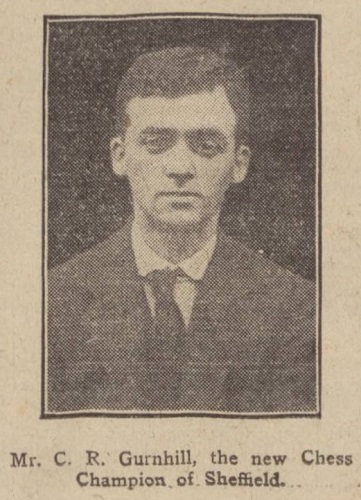
Sheffield Daily Telegraph, 15 June 1928, page 5
Following on from the reference to C.R. Gurnhill in C.N. 11036, below is a game in which, playing Black against D.G. Ellison, he castled twice:
1 e4 e5 2 Nf3 Nc6 3 d4 exd4 4 c3 dxc3 5 Bc4 Be7 6 Nxc3 Nf6 7 e5 Ng4 8 Qd5
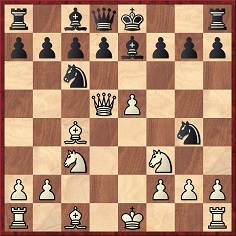
8...O-O 9 h3 Nh6 10 Bxh6 gxh6 11 Qe4 Kg7 12 Bd3 Rh8 13 Qg4+ Kf8 14 Qh5 Bg5 15 h4 Be7 16 Qxh6+ Ke8 17 Qg7 Rf8 18 Bxh7 d5 19 O-O-O Be6 20 Be4 Nxe5 21 Nxe5 Bf6 22 Qg3 c6 23 f4 Qa5 24 Bc2
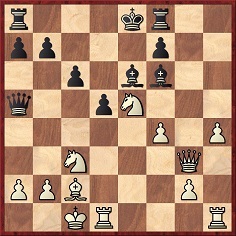
24...O-O-O
The illegality of this move was indicated by a looker-on, and Black therefore played 24...Rd8. The game ended 25 Bb3 Bf5 26 Rhe1 Be7 27 Qe3 Be6 28 f5 d4 29 Rxd4 Rxd4 30 Qxd4 Bxb3 31 Qd7 mate.
The occasion was the Major Open of the British Chess Federation Congress in Sunderland in August 1966, as reported on pages 285-286 of the October 1966 BCM:
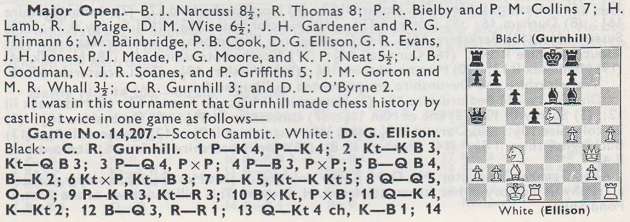

When the topic of double castling arises, the game commonly referred to is W. Heidenfeld v N. Kerins, Dublin, 1973. On page 70 of Chess Curiosities (London, 1985) Tim Krabbé quoted from a report by P. Cassidy on page 236 of the June 1973 BCM (which stated that the game had been played ‘in this year’s Armstrong Cup’) but could not present the game-score. It was published on page 76 of the February 1988 BCM when J. Walsh submitted it to K. Whyld’s Quotes and Queries column. The source was vague: ‘from a recent issue of the Irish Chess Journal’. The full score:
1 e4 e6 2 d4 d5 3 Be3 Nf6 4 e5 Nfd7 5 f4 c5 6 c3 Nc6 7 Nf3 Qb6 8 Qd2 c4 9 Be2 Na5
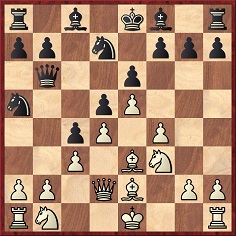
10 O-O f5 11 Ng5 Be7 12 g4 Bxg5 13 fxg5 Nf8 14 gxf5 exf5 15 Bf3 Be6 16 Qg2 O-O-O 17 Na3 Ng6 18 Qd2 f4 19 Bf2 Bh3 20 Rfb1 Bf5 21 Nc2 h6 22 gxh6 Rxh6 23 Nb4 Qe6 24 Qe2 Ne7 25 b3 Qg6+ 26 Kf1 Bxb1 27 bxc4 dxc4 28 Qb2 Bd3+ 29 Ke1 Be4 30 Qe2 Bxf3 31 Qxf3 Rxh2 32 d5 Qf5

33 O-O-O Rh3 34 Qe2 Rxc3+ 35 Kb2 Rh3 36 d6 Nec6 37 Nxc6 Nxc6 38 e6 Qe5+ 39 Qxe5 Nxe5 40 d7+ Nxd7 41 White resigns.
The game is on pages 41-42 of Startling Castling! by Robert Timmer (London, 1997), followed by this comment:
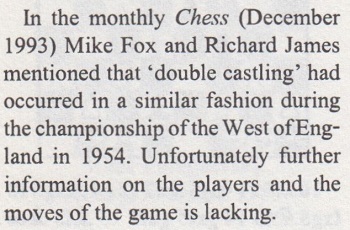
Below is that Fox/James item (CHESS, December 1993, page 53), after the game Heidenfeld v ‘Kerine’ had been given.
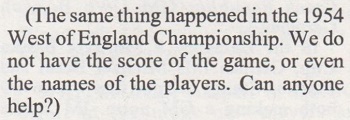
No mention was made of a paragraph by K. Whyld on page 171 of the April 1988 BCM, also after a reference to Heidenfeld v Kerins:
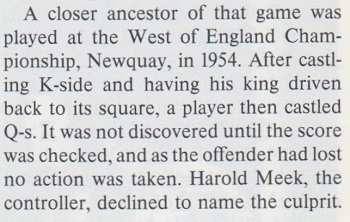
In that snippet too the reader was given no source for the statements.
We can, though, show what appeared on page 131 of CHESS, June 1954:
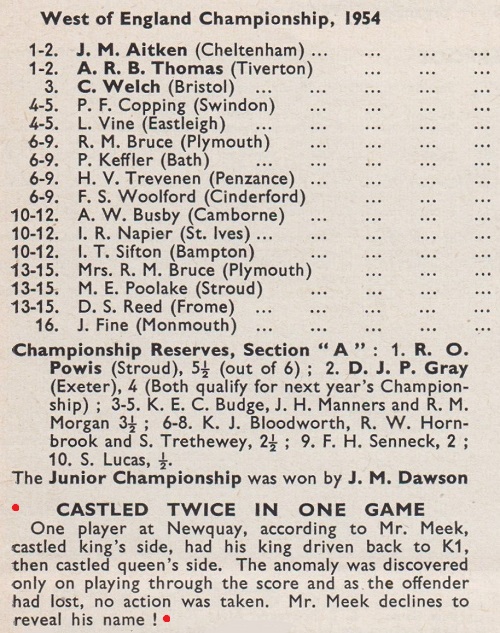
The reference to Meek may surprise anyone consulting Chess Personalia by Jeremy Gaige (Jefferson, 1987) and finding his year of birth given as 1865. However, Meek was not aged nearly 90 at the time of the Newquay tournament. As reported in C.N. 4836, the privately-circulated 1994 edition of Chess Personalia had a corrected, expanded entry:
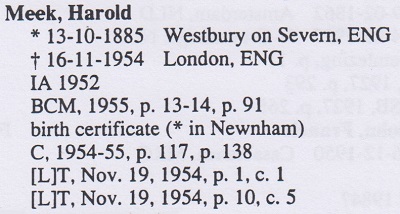
Page 35 of the British Chess Federation Year Book 1954-1955 (London, 1955) confirms that Meek died ‘at the age of 69’.
11038. The catastrophe of chess play
On page 10 of the January 1960 BCM (Quotes and Queries item 1614) D.J. Morgan wrote:
‘It was Adolf Bayersdorfer (184[2]-1901) who called the chess problem “the catastrophe of chess play concentrated in a few moves”.’
No source was given, and the closest citation that we can offer is from page 37 of the Bayersdorfer book Zur Kenntnis des Schachproblems (Potsdam, 1902):
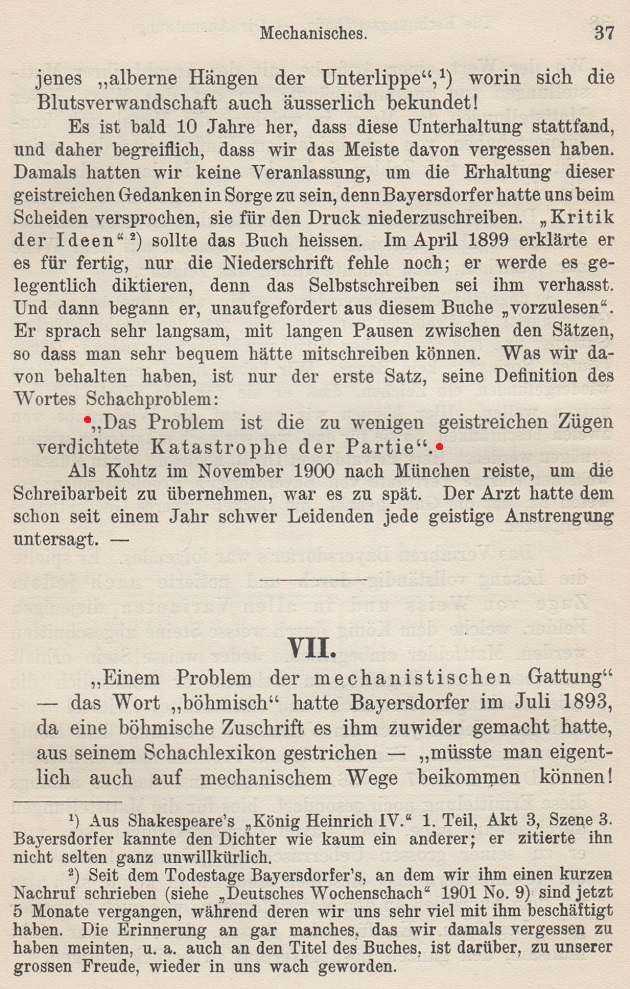
The indented quote is thus a remark by Bayersdorfer as recorded by the book’s editors, J. Kohtz and C. Kockelkorn.
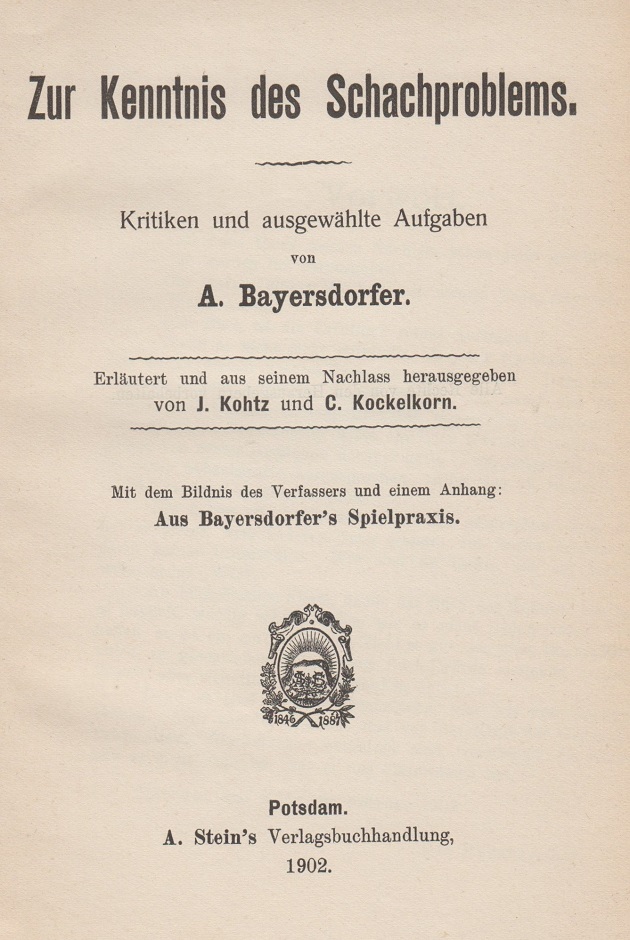
A photograph of Bayersdorfer, the book’s frontispiece, is in C.N. 7620.
11039. Purdy on Capablanca
From page 184 of the Australasian Chess Review, 9 July 1936, in a report written during the Moscow, 1936 tournament:
‘Among the great, Capablanca can be great, because he does not have to play to avoid draws. He has not Alekhine’s gift for beating inferior players, but when all the competitors are of his own class, he can give free rein to his natural style – classical simplicity.’
11040. The Bordell case
With regard to the Bordell case, documentation is still sought to show how the Spanish press covered the non-participation of Román Bordell Rosell in Hastings, 1953-54.
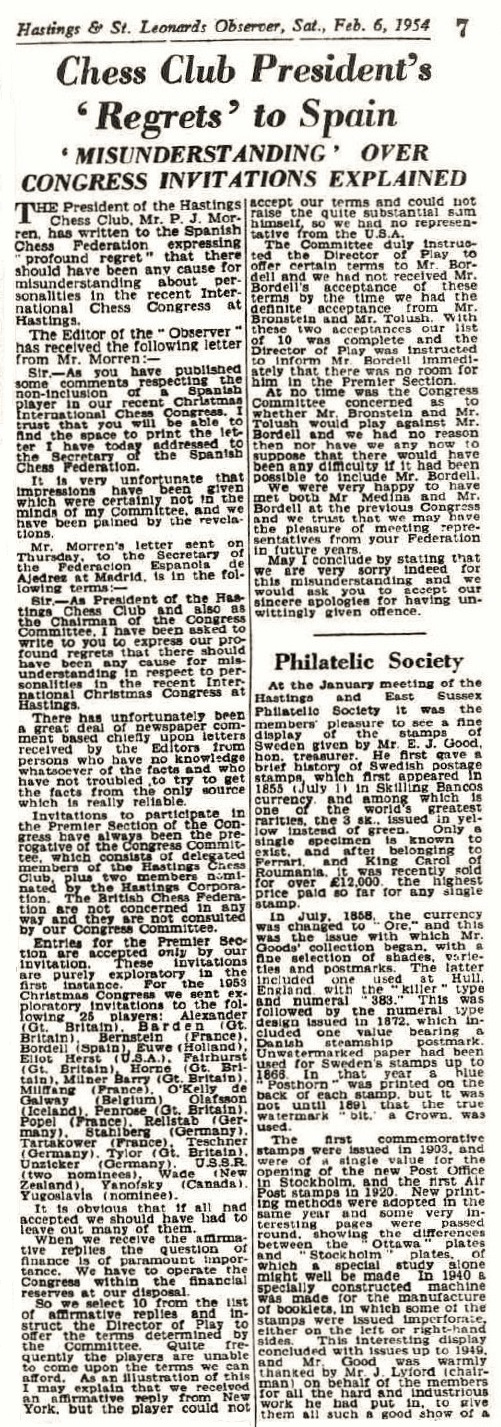
11041. Heidenfeld v Kerins (C.N. 11037)
David McAlister (Stirling, Scotland) provides page 10 of the first issue (November-December 1987) of the Irish Chess Journal:
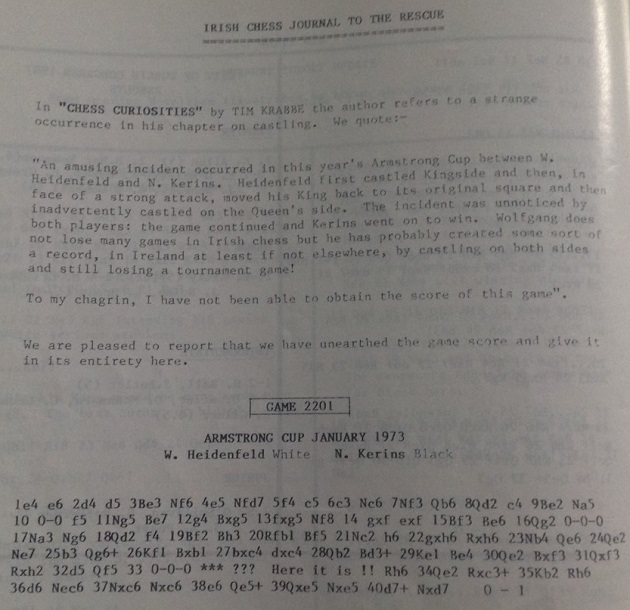
11042. Mecking
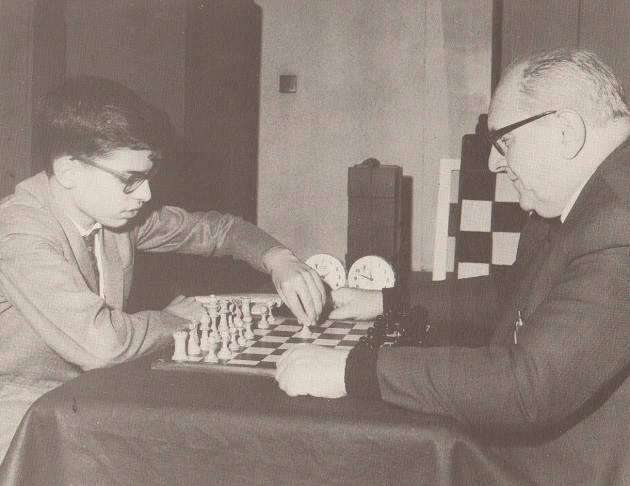
Henrique Mecking’s opponent will be the subject of a C.N. item shortly.
11043. Moshe Czerniak
The photograph in the previous item comes from page 107 of The Children’s Book of Chess by Ted Nottingham and Bob Wade (London, 1978 and New York, 1979), which had the caption ‘Mecking at Hastings, England’.
His opponent was not named, but we identify him as Moshe Czerniak. At the Hastings tournament on 5 January 1967, Mecking won their game (playing Black), as reported on pages 39-40 of the February 1967 BCM.
A book by Czerniak, ‘The History of Chess’ (Tel Aviv,
1963), has been mentioned to us by Moshe Rubin
(Jerusalem). It includes many reminiscences, and our
correspondent has forwarded a file comprising
the original Hebrew text of these vignettes, alongside his
translation into English. See too C.N. 4143.
An occasional inaccuracy by Czerniak will be noted (such as Rubinstein’s year of death). One remark is worth considering in conjunction with C.N. 11039:
‘In 1939 Capablanca admitted to me that “for some reason” it was difficult for him to beat even quite weak opponents (he was referring to average-strength masters) ...’
11044. An old ending
Danny Ross Lunsford (Atlanta, GA, USA) asks for information about the ending shown in C.N. 9421:
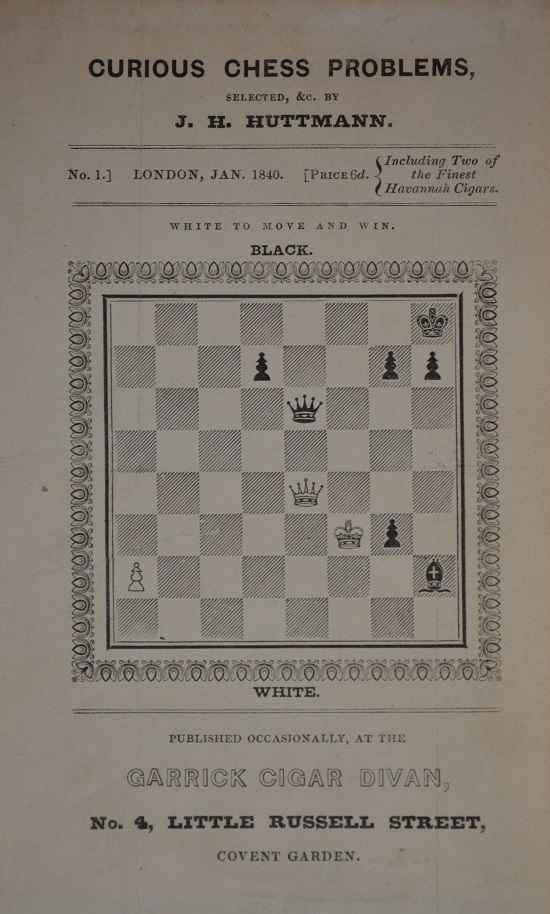
It is a composition by Ponziani and can be found in various editions of his work Il giuoco incomparabile degli scacchi. Google Books is invaluable for providing them, and below is the ending as given on pages 207-208 of the second edition (Modena, 1782):
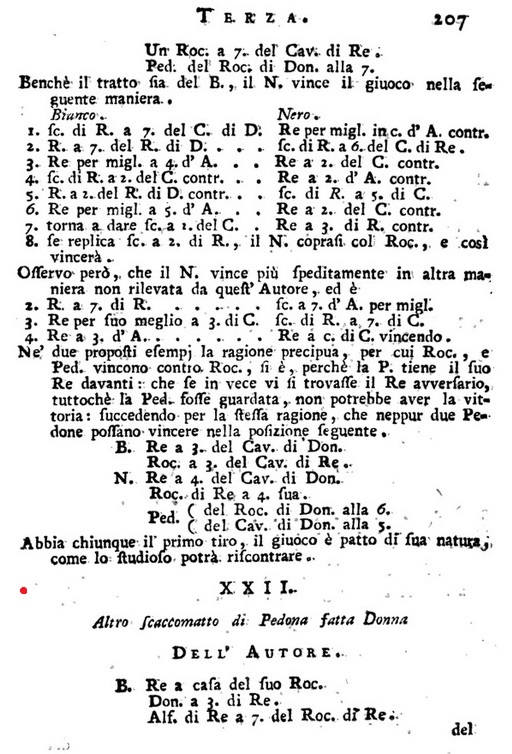
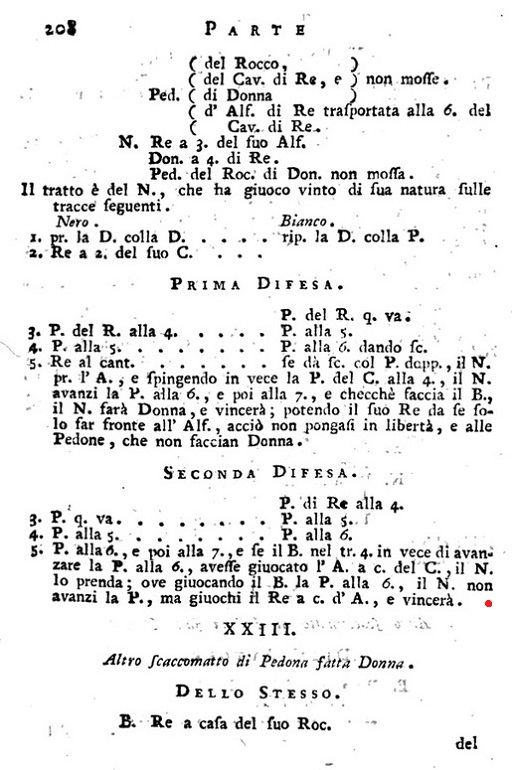
11045. Possible Fischer events (C.N. 10989)
C.N. 10989 showed this report:

An addition from page 157 of CHESS, March 1973:
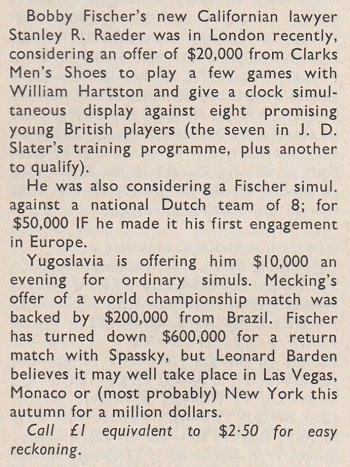
Leonard Barden (London) informs us:
‘I was contacted in early 1973 by Clarks Shoes, who wanted to sponsor a chess event involving Bobby Fischer. Since the maximum budget (probably £10,000, but I do not recall exactly now) was unrealistically low, I suggested Spassky instead, but the company was adamant that only Fischer would be acceptable.
After consultation with Stewart Reuben, I contacted Stanley Rader with a proposal for a two-game match between Fischer and the then England No. 1, William Hartston, with games in London and York, plus a clock simultaneous display against eight English juniors.
I had zero expectation that this offer would be accepted. My hope was that the match format would be quickly rejected (“Two games? You gotta be joking!”), but that Fischer would be interested in the simultaneous exhibition with clocks.
My main basis for optimism was that in July 1972, after Fischer accepted Jim Slater’s offer to double the prize fund at Reykjavik, his then lawyer Paul Marshall told me that Fischer was very grateful and that as a thank-you would play in England in his first event after he won the title. Of course, I told that to Stanley Rader. My hope also was that a clock simultaneous exhibition against eight opponents, two of whom would be girls, would sound sufficiently lightweight for Fischer to accept as an easy way of keeping his promise to Slater.
The small print, and the reason I took the trouble to be involved in such a time-consuming episode, was that the England junior team would have been Tony Miles, Michael Stean, John Nunn, Jonathan Mestel and Jonathan Speelman, all future strong grandmasters, plus one other undecided name (probably David Goodman). The girls would have been Sheila Jackson and Susan Caldwell, the obvious choices at that time.
I was also ready, if it clinched the event, to reduce the numbers to just the five players who I was sure had world-class potential.
There was no reply from the United States for several weeks, and Clarks Shoes became fidgety, so I telephoned Stanley Rader’s office and repeated the proposal, emphasizing that there was room for negotiation and that the event was possible as just a five-board simultaneous exhibition. Rader told me that Fischer was physically present in his office, and put me on hold while they spoke. Fischer knew me well from our BBC consultation game and his 1960 visit to my home, but would not speak directly to me. Rader told me that Fischer was undecided and that they would let me know later. After a couple of weeks a final negative reply came. At some stage, possibly after the breakdown of negotiations, a story about the abortive match appeared in the Daily Telegraph mentioning Clarks Shoes as the would-be sponsor. Clarks paid me just £100 for my work in trying to arrange the event, so received excellent value for that outlay in the subsequent publicity.’
11046. Chess is what you see
C.N.s 7122 and 7216 showed publications which attributed to Pillsbury the remark ‘Chess is what you see’.
The first C.N. item quoted from page 8 of the New Orleans Times-Democrat, 26 December 1897, and below is a slightly earlier specimen, in a letter from H.C. White on page 6 of the New York Sun, 12 December 1897:
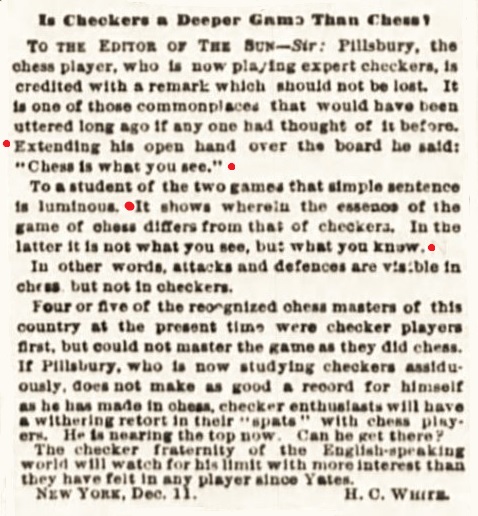
A twinned version of the remarks on chess and checkers, without mention of Pillsbury by name, was in William Timothy Call’s Preface to his work Ellsworth’s Checker Book (New York, 1899), page 5:
‘Quoting a great chess master, who is also a checker expert, he [Charles Ellsworth] would say: “Chess is what you see; checkers is what you know”.’
On the Internet it is possible to find such an observation attributed, sourcelessly, to Pillsbury with a third Lego block:
‘Chess is what you see, Checkers is what you know. There is enough in either game to last a man a lifetime.’
Regarding the ‘lifetime’ remark, we note the following on page 15 of R.D. Yates Checker Player by W.T. Call (New York, 1905):
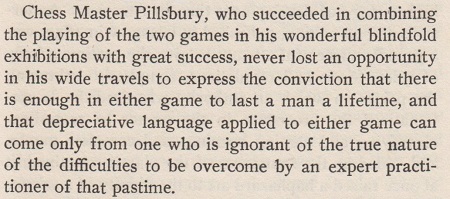
11047.
Another Pillsbury problem (C.N.s 702, 3751 & 9458)
From page 224 of Womanhood, 1903:
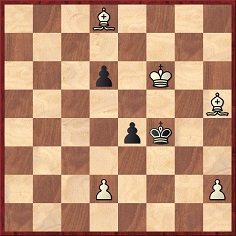
Mate in three
The heading was ‘Specially composed for Womanhood by H.N. Pillsbury’. The following issue (page 296) noted that there were two solutions.
11048. Good and bad bishops (C.N.s 7769 & 10844)
Gerd Entrup (Herne, Germany) notes references to ‘good’ and ‘bad’ bishops in the feature ‘Lehrreiche Endspiele’ on pages 330-332 of the November 1933 Wiener Schachzeitung. The initial comments on the two endgames (Löwig v Klein and Tot v Schreiber) are, respectively:
‘Schwarz besitzt den guten Läufer (der dieselbe Felderfarbe hat wie die feindlichen Bauern) und ist in der Lage, die Überlegenheit des Lg8 über den Lc4 (den schlechten Läufer mit derselben Felderfarbe wie die eigenen Bauern) entscheidend zur Geltung zu bringen.’
‘Auch dieses Endspiel geht für den schlechten, durch seine eigenen Bauern gehemmten Läufer verloren.’
11049. Euwe v Donner
Drawing attention to a Dutch news film report (5 January 1956), Wijnand Engelkes (Zeist, the Netherlands) comments:
‘In his 1955-56 match against Donner for the Dutch championship, Euwe had just won the seventh game, taking a strong lead. In the film report his daughter Caroline explains that she and her sisters have teased their father by turning objects in his house upside down, threatening to leave them like that if Donner were to win the match. Donner said that if he won, he would go to Euwe’s house and remove most of the hideous furniture.’
The second screen-shot, below, is from further footage of the Euwe-Donner match:
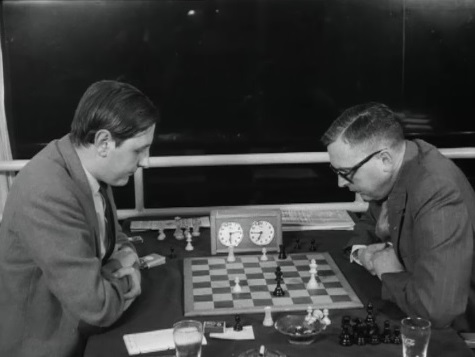
11050. Tom Driberg and John Rety
From page 8 of Chess for Children by Ted Nottingham, Bob Wade and Al Lawrence (New York, 1993 and 1996):
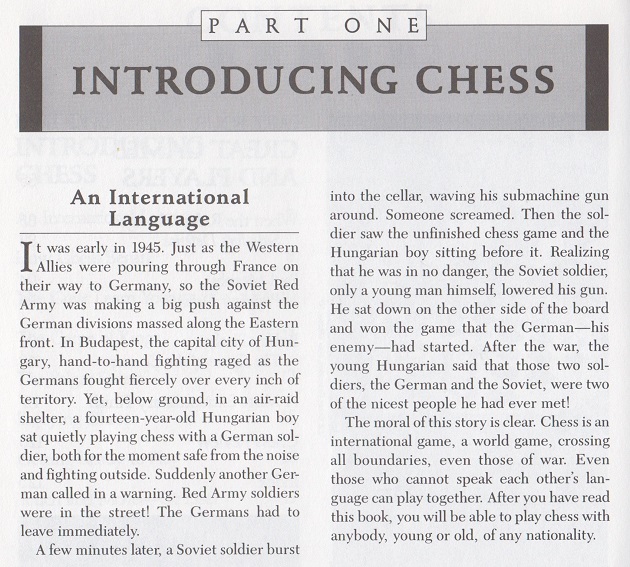
The list of acknowledgements on page 5 included:
‘The late Tom Driberg MP, for “An International Language”, from his report in The Reynolds News, London, 1947.’
Can a reader provide that report? For now, we must make do with Driberg’s text as published on page 168 of King, Queen and Knight by N. Knight and W. Guy (London, 1975):
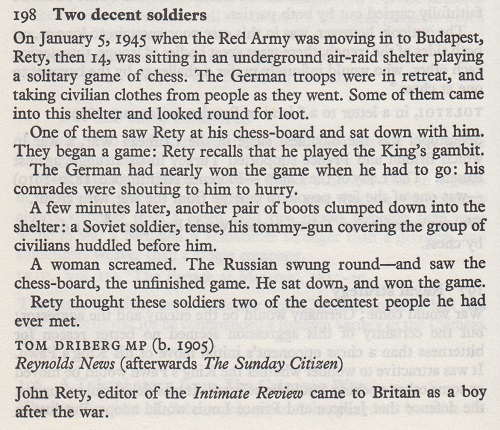
Rety was the translator of Planning in Chess by J. Flesch (London, 1983), named there as ‘John Réti’. Elsewhere, ‘Reti’ and ‘Réty’ are also found.
11051. A legal judgment on the educational value of chess
Page 182 of CHESS, 28 March 1963 had a filler paragraph of legalese:

Chess in the Courts provides this summary of the case:
1944: Dupree’s Trusts, Daley and Others v Lloyds Bank, Limited and Others (C.N. 360)
The question arising in this case was whether chess was of sufficient educational value for a gift to encourage chessplaying to qualify as a valid charitable gift. The verdict was yes, whilst acknowledging that the whole affair was rather a slippery slope: ‘If chess, why not draughts: if draughts, why not bezique, and so on, through to bridge, whist, and, by another route, stamp collecting and the acquisition of birds’ eggs?’, concluded J. Vaisey of the Chancery Division. This affair was brought to our attention by Paul Timson (Whalley, England), who provided a copy of the judgment.
Below, from our correspondence file, is the full text
forwarded by Mr Timson in 1983 (pages 443-445 of the All
England
Law Reports Annotated, volume 2, 18 November 1944).
The text quoted, not quite accurately, by CHESS is
on page 444.
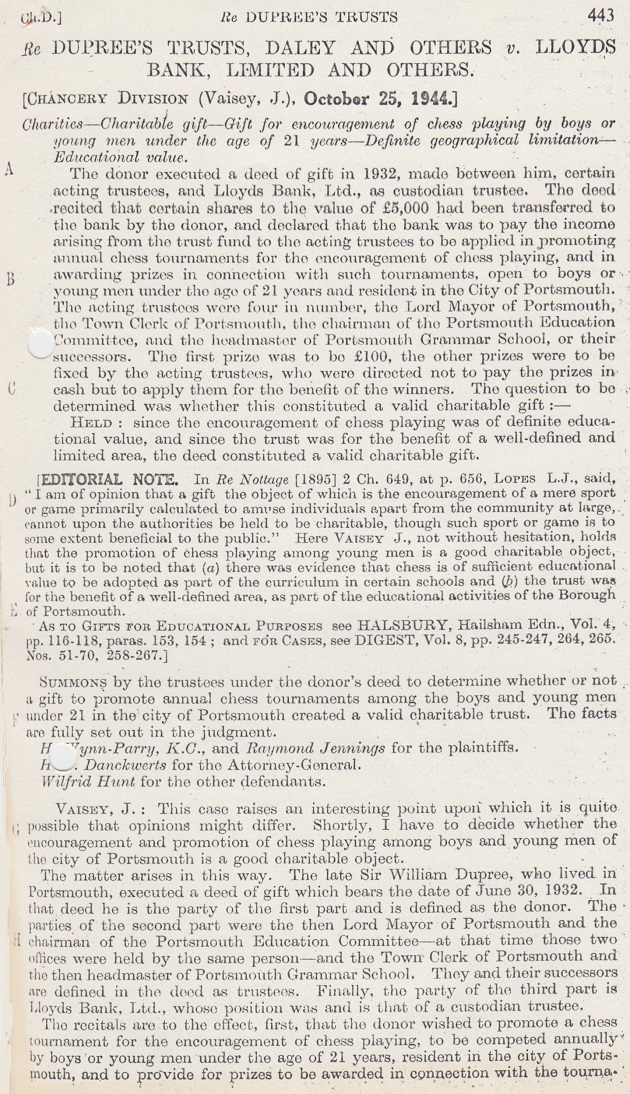
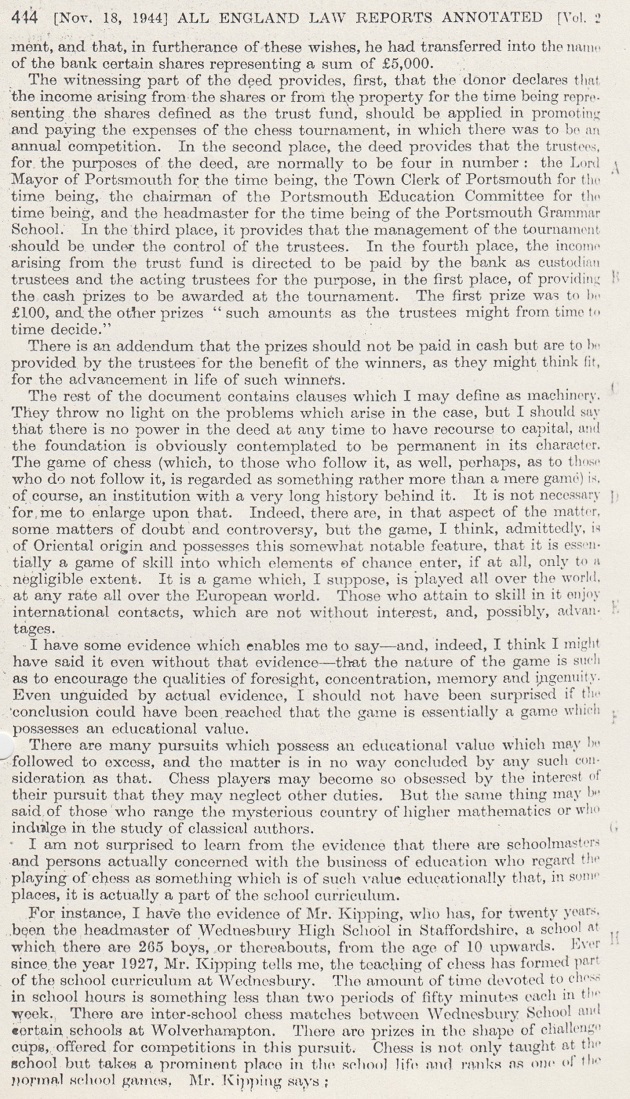
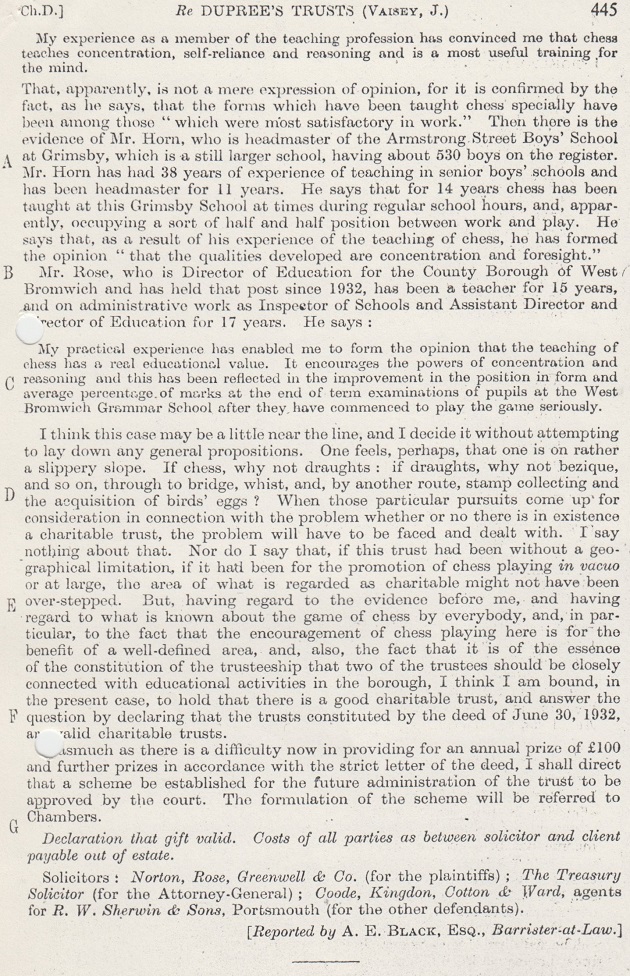
11052. Tartakower v N.N.
From page 462 of L’Echiquier, 5 April 1934, in a ‘fins de partie curieuses’ article by Tartakower:

11053. Quotes by Fenton and Golombek
A Quotes and Queries item by D.J. Morgan on page 446 of the October 1973 BCM:

Since no sources were specified, they are added below.
The Fenton remark ‘Never try to checkmate your opponent, but try to win the game’ can be seen in C.N. 10355, which had an extract (pages 233-234) from an article about Purssell’s chess resort in the May 1891 BCM.
A further passage concerning Fenton from the same article:
‘When the end approaches, if by chance he is losing, he gives in without submitting to the last indignity of the game, and he freely advises his opponents to do the same. “Never allow yourself to be checkmated”, he often says. “No human being has ever seen me checkmated yet.”
Golombek’s ‘The tactical master may or may not develop into a great player, the positional one always does’ comes from page 16 of The Games of Robert J. Fischer edited by Robert G. Wade and Kevin J. O’Connell (London, 1972). Golombek contributed an introductory essay, ‘Fischer the Artist’.
On page 15 Golombek wrote:
‘The game of chess is neither a sport nor a science, but really an art.’
11054. Flohr on Capablanca (C.N.s 11039 & 11043)
A third observation about Capablanca’s play in the 1930s:
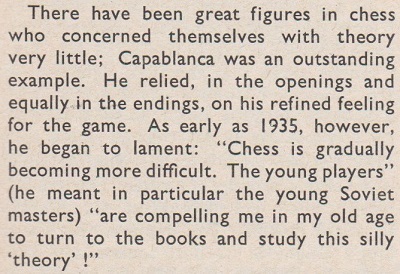
Source: an article entitled ‘Chess Theory is Grey’ by Salo Flohr on pages 157 and 180 of CHESS, March 1967. No information about the article’s provenance was supplied, or about the circumstances of Capablanca’s alleged incipient lamentation.
11055. The Bordell case
Further to the request in C.N. 11040, information on how the Spanish press handled the Bordell case has been provided by Eduardo Bauzá Mercére (New York, NY, USA) and Roberto Roig (Lima), both of whom have sent a report on page 50 of ABC, 7 February 1954:
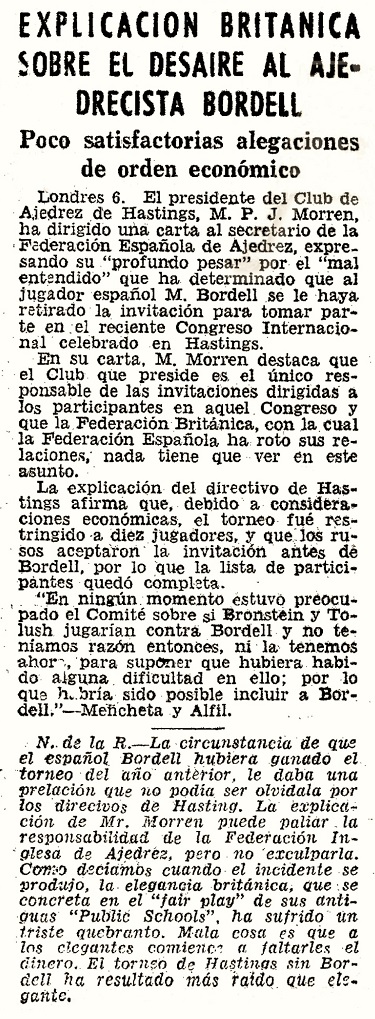
In addition to three more cuttings, from ABC and La Vanguardia, which are being added direct to our feature article, Mr Bauzá Mercére has forwarded an item on page 33 of Ajedrez Español, January-February 1954:
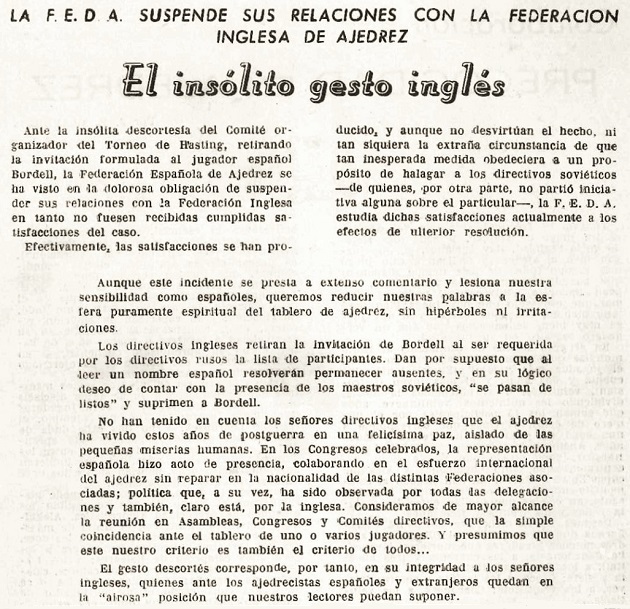
11056. Plagiarism in CHESS
Olimpiu G. Urcan (Singapore) points out a ‘Myths & Legends’ article on pages 40-41 of CHESS, October 2018 in which Charles Higgie discusses Capablanca v Marshall, New York, 1918.
He lists three ‘myths’, and those 32 lines of text contain no facts not given in our feature article on the Marshall Gambit. There is even some verbatim copying, without a word of acknowledgement.
Concerning untrue claims that Marshall saved his Gambit for many years in order to surprise Capablanca, we wrote:
... between 1910 and 1918 the Cuban played 1 e4 against Marshall on six occasions. Five times the American responded with the Petroff Defence and once with the French Defence.
From Charles Higgie’s article:
‘Between 1910 and 1918 the Cuban played 1 e4 against Marshall on six occasions. Five times the American responded with the Petroff Defence and once with the French Defence.’
With regard to the game Frere v Marshall supposedly played in 1917, our article states:
Marshall published the Frere game on pages 110-111 of his rarely-seen book Comparative Chess (Philadelphia, 1932). ... A further curiosity in Comparative Chess is that on page 104 it was 7…O-O, rather than 8…d5, that Marshall emphasized. Of 7…O-O he wrote (incorrectly), ‘This move of mine, I claim to be original’.
Charles Higgie’s version:
‘Marshall published the Frere game on pages 110-111 of his rarely seen book Comparative Chess. A further curiosity in Comparative Chess is that on page 104 it was 7...O-O, rather than 8...d5, which Marshall drew attention to. Of 7...O-O, he wrote (incorrectly), “This move of mine, I claim to be original”.’
From page 3 of that issue of CHESS:

11057. Endeavour and Poirot
Books by which chess author appear in both Endeavour (Shaun Evans) and Poirot (David Suchet)?
The answer is below. (The episodes of these ITV programmes were entitled, respectively, ‘Game’ and ‘The Big Four’.)

The answer is E.E. Cunnington (1852-1942).
Near the beginning of the Endeavour episode, the eponymous detective briefly handled a copy of Chess Lessons for Beginners:
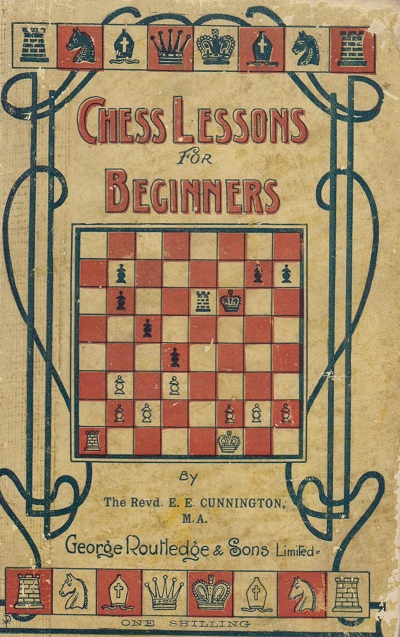
‘The Big Four’ has a short scene, also early on, in which Hercule Poirot was researching the Ruy López in a large-format book with a fictitious cover and title (The 50 Greatest Chess Problems – author’s name indistinct). The content fleetingly shown is identifiable as being from Cunnington’s Chess Traps and Stratagems.
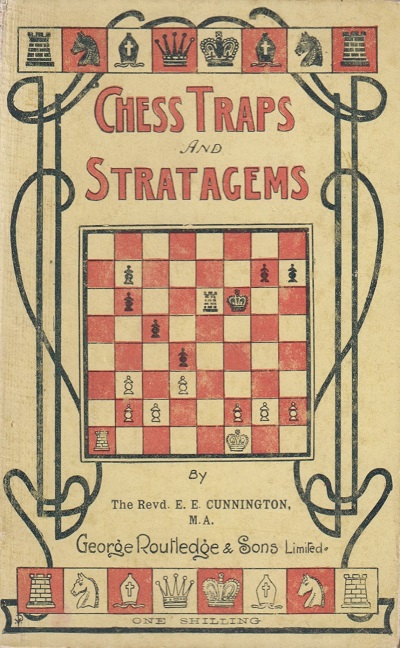
Below are the pages from which fragments of text and diagrams can be seen, just about, in ‘The Big Four’, although the lay-out was altered:
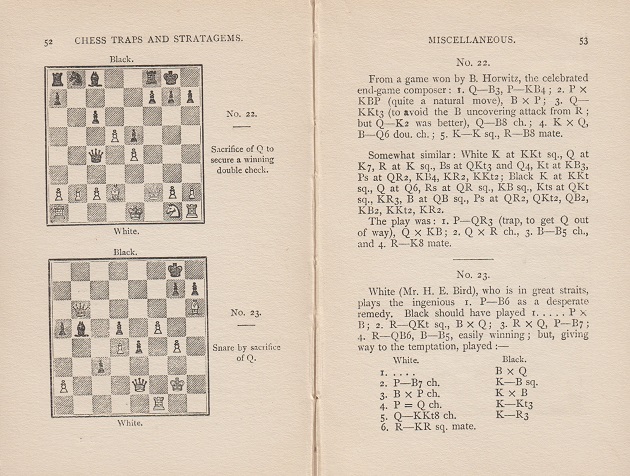

11058. Fischer v Bolbochán
From pages 197-198 of Modern Chess Brilliancies by Larry Evans (New York, 1970/71):
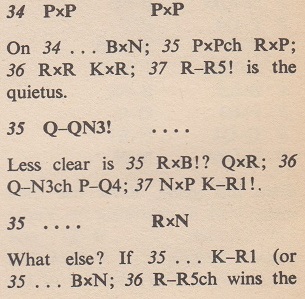
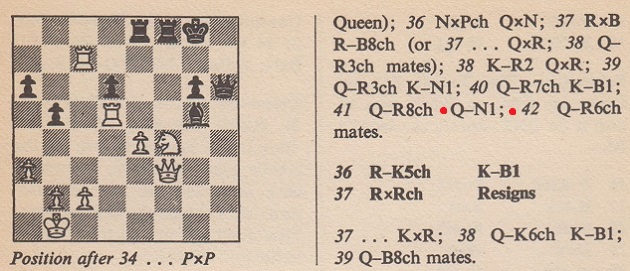
On pages 322-323 of CHESS, July 1976 Irving Chernev wrote:
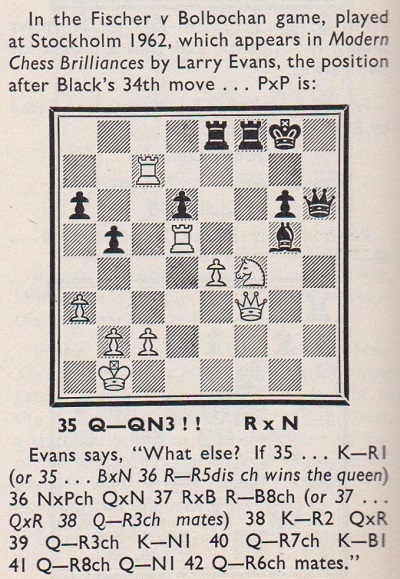

As shown in Fischer’s Fury, Evans made no correction on page 249 of the algebraic edition of Modern Chess Brilliancies (San Francisco, 1994):
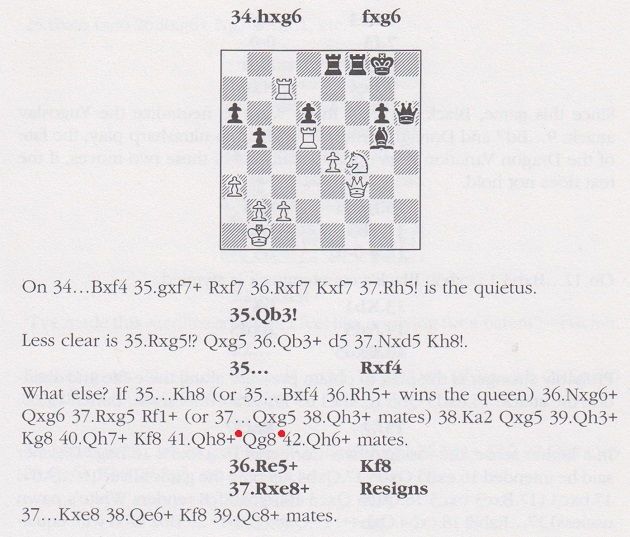
Tony Bronzin (Newark, DE, USA) wonders how such a mistake could have occurred at all in Modern Chess Brilliancies, given a claim by Evans about Fischer on page 16 of Chess Life, March 2008:
‘That year [1969] he was my house guest in Reno. I was working on the manuscript of Modern Chess Brilliancies and asked him to check it for errors. He wanted $100 and I paid it gladly. He went through the games blindfolded and did a wonderful job.’
11059. Déjà vu
Apish ‘tributes’ to Bobby Fischer on page 21 of Chess Life, March 2008:
‘He was the pride and sorrow of chess.’ (Raymond Keene)
‘Chess was his native tongue.’ (Larry Evans).
11060. Fenton and Cubison
The final paragraph of the article about R.F. Fenton on pages 77-80 of the March 1916 BCM which was mentioned in C.N. 7965:
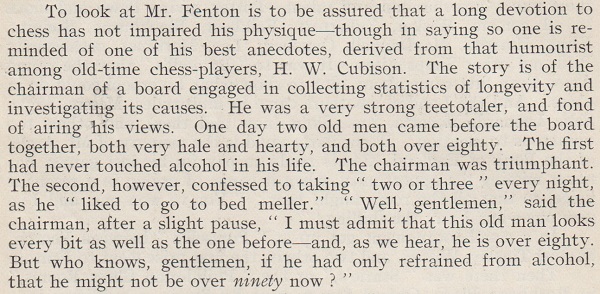
The article was unsigned, but O.C. Müller believed the writer to be P.W. Sergeant. See the appeal on behalf of Fenton’s widow on page 275 of the June 1916 Chess Amateur.
Information about Cubison (whose initials were W.H.) will be appreciated.
Page 233 of the Chess Player’s Chronicle, 1 October 1878 had an acrostic by him on Zukertort:
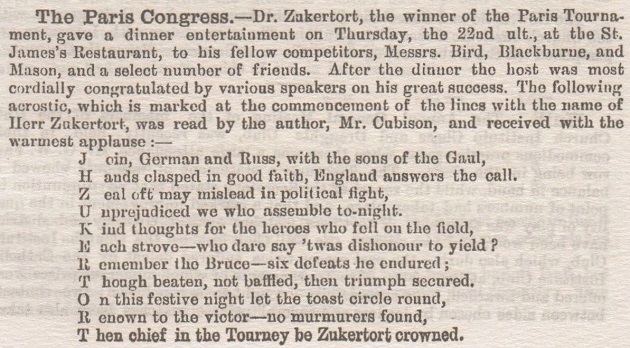
The May 1889 issue of Hoffer’s Chess Monthly (pages 259-260) published a poem by Cubison in commemoration of Kolisch, and page 265 of the same issue carried, anonymously, the notorious ‘Sty-nits’ verse. On page 180 of the June 1889 International Chess Magazine Steinitz deduced that Cubison had written that poem too, an accusation for which he apologized ‘most sincerely and to the fullest extent’ on page 298 of the October 1889 issue of his magazine.
11061. R.D. Yates (C.N.s 4425 & 11046)
An assessment of Robert D. Yates, including references to chess, on pages 55-56 of R.D. Yates Checker Player by W.T. Call (New York, 1905):
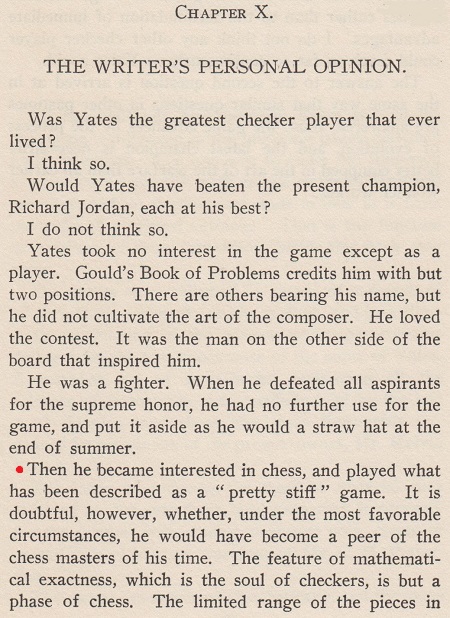
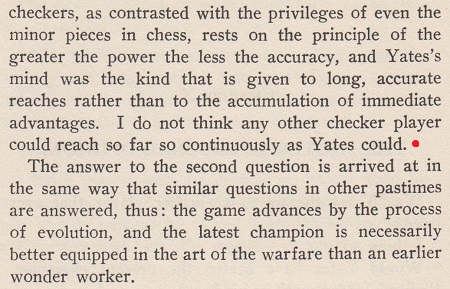
Page 3 of the Brooklyn Chess Chronicle, 15 October 1883 reported on a meeting of the Danites Chess Club of Brooklyn on 27 September:
‘Mr Robert Yates, the well-known champion checker player, was present and showed that he could also play chess.’
See too page 34 of the February 1907 American Chess Bulletin, which had comments on Yates by George S. O’Flyn, the originator of Spy-Chess.
This photograph is reproduced with the permission of the Cleveland Public Library:
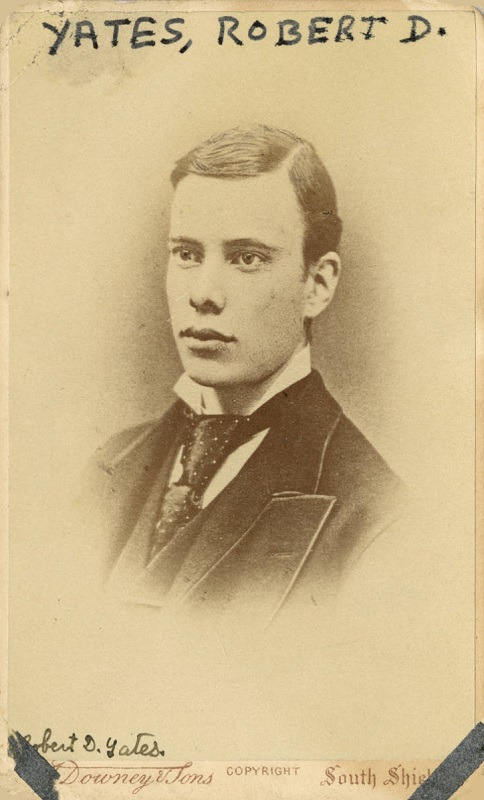
There are webpages which state that Yates died, at the age of 27, on 19 September 1885. As shown below, his death had already been announced earlier that month:
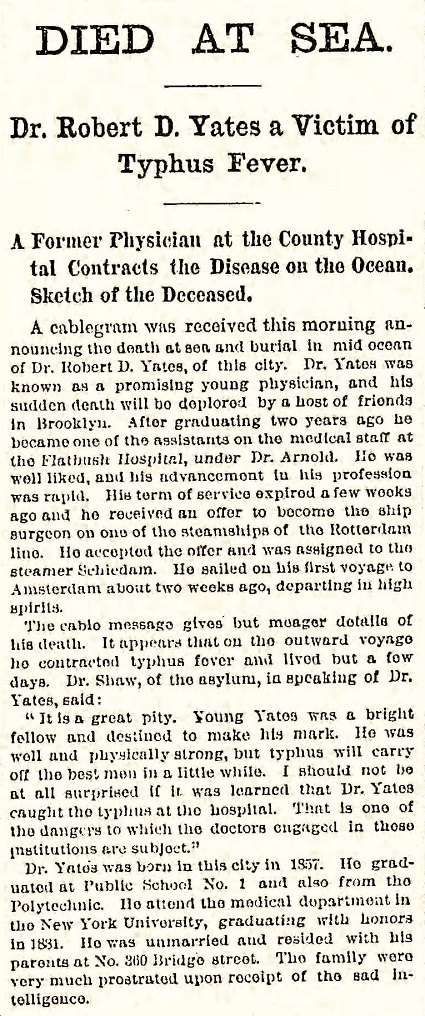
Brooklyn Daily Eagle, 2 September 1885, page 4
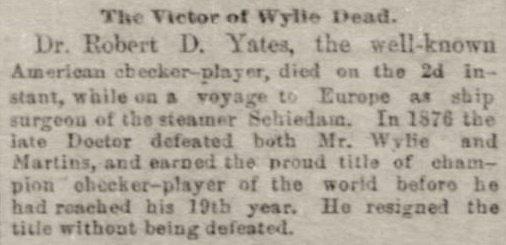
Pittsburgh Commercial Gazette, 12 September 1885, page 5
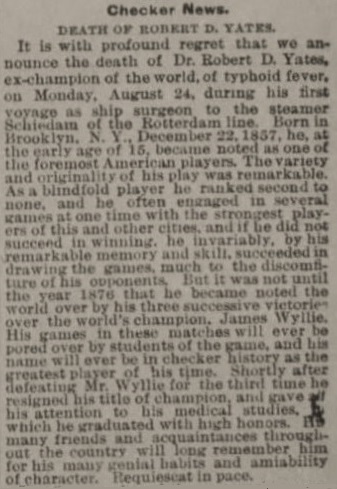
Boston Weekly Globe, 22 September 1885, page 3.
The contradictory death-dates will be noted.
Biographical information on Yates and a number of his games can be found in The Compleat Draughts Player by Irving Chernev (Oxford, 1981).
11062. Scientist/monk/beast of prey (C.N.s 6587, 6596, 8138 & 8958)
From page 22 of Aleksandr Alekhin by A. Kotov (Moscow, 1973):
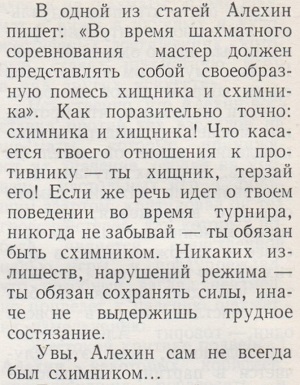
The English translation by K.P. Neat on page 16 of Alexander Alekhine (London, 1975):
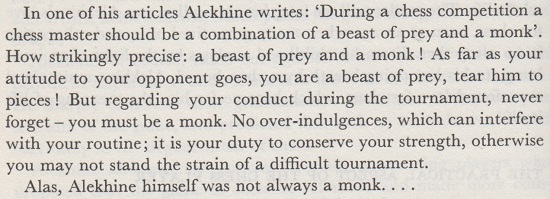
Kotov’s output on Alekhine is bestrewn with unsourced quotes. Regarding the one under discussion here, we have yet to find anything relevant in his two-volume work Shakhmatnoe Nasledie A.A. Alekhina (Moscow, 1953 and 1958).
11063. Copenhagen, 1946 (C.N. 9477)
In C.N. 9477 a correspondent pointed out that on page 4 of ‘Mr Chess’ The Ortvin Sarapu Story (Wainuiomata, 1993) Sarapu stated incorrectly that he won the 1946 Copenhagen championship.
L. Ross Jackson (Raumati South, New Zealand) notes that no such claim was made in a biographical article on pages 177-178 of the August 1952 Chess World, which incorporated information received first-hand from Sarapu:
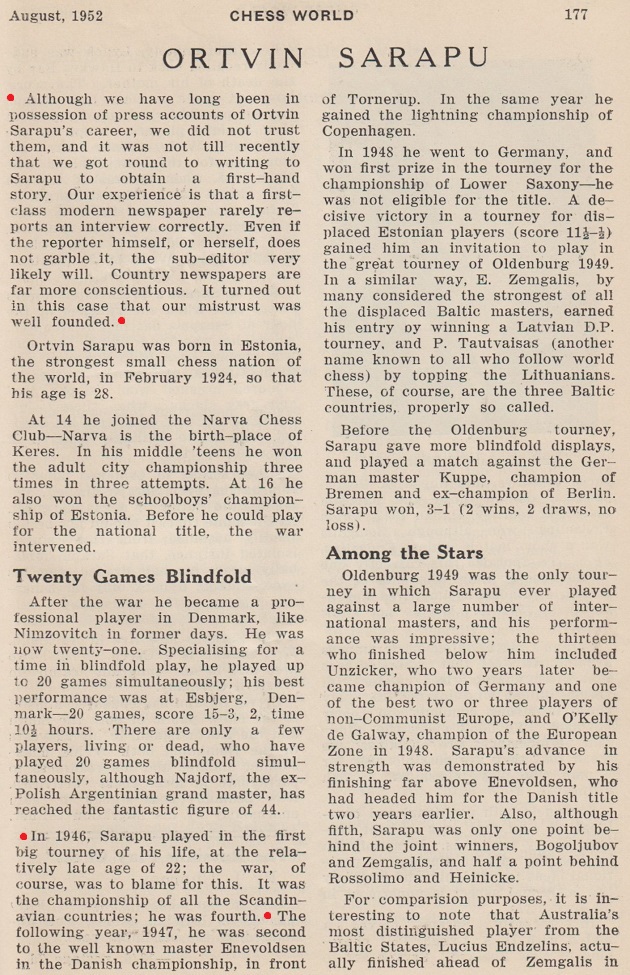
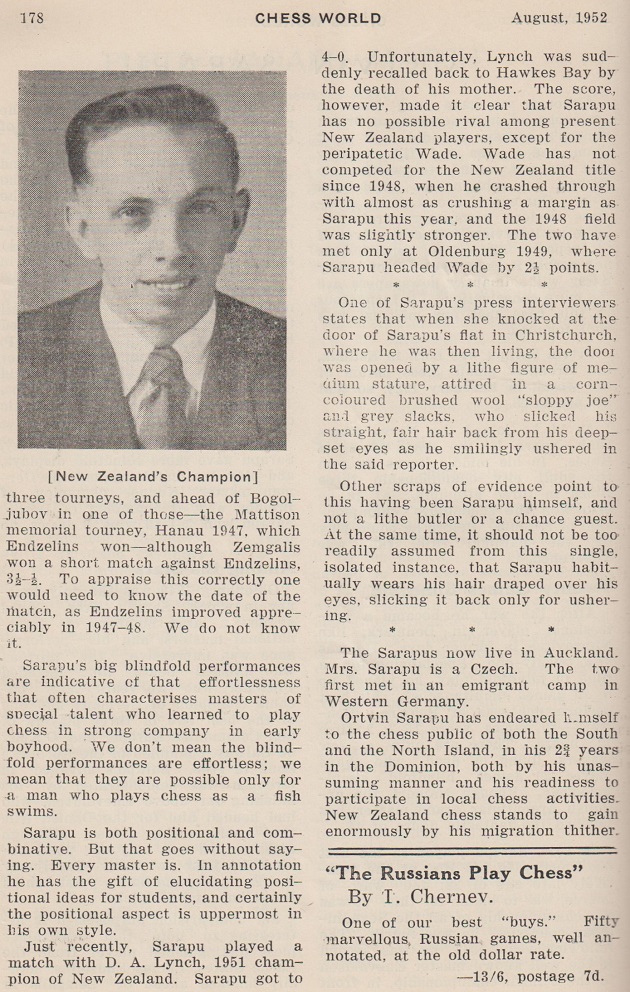
11064. Responsibilities
A remark by Steinitz on page 180 of the June 1889 International Chess Magazine:
‘Every well-known contributor to a public journal is at least in some measure responsible for the conduct of the publication which he associates his name with.’
11065. W.H. Cubison (C.N. 11060)
Cubison was quoted at the start of an obituary on page 235 of the April 1884 Chess Monthly:

For further information about Prince Leopold, Duke of Albany, see C.N.s 4044, 4066, 4558 and 8126.
Cubison’s first forename was given as William in Frank Healey’s chess column on page 445 of The Ladies’ Treasury: A Household Magazine, 1 July 1890:

11066. Draughts/checkers
Our latest feature article is Chess and Draughts/Checkers.
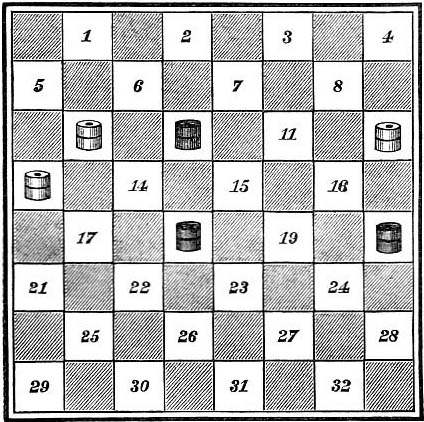
White wins
11067. Planning
Concerning planning, Konstantin Dushenko (Moscow) draws attention to a passage published in 1822:
‘Want of plan may not, in every case, be the cause of all this misery; because accident enters into life for something, both in the unfavorable as well as the favorable side of the question; but we have no hesitation in asserting, that want of plan, as a cause of misery, is as ninety-nine to a hundred. Any plan at all, even a bad plan, is better than none; because those who set out on any plan will, in all probability, sooner discover its errors, if a bad one, and correct them, than those, who set out on no plan, will discover the want of one, and form a good plan. – Plan, in short, is predestination, as conduct is fate.’
Source: An Encyclopædia of Gardening by J.C. Loudon (London, 1822), page 1336.
Our correspondent points out that the text has been mentioned on a ChessPro page, which also has non-chess references from the nineteenth century to ‘Gens una sumus’.
11068. Ernest Kim (C.N.s 8884, 8886, 9742 & 9756)
Eduardo Bauzá Mercére (New York, NY, USA) provides three cuttings:
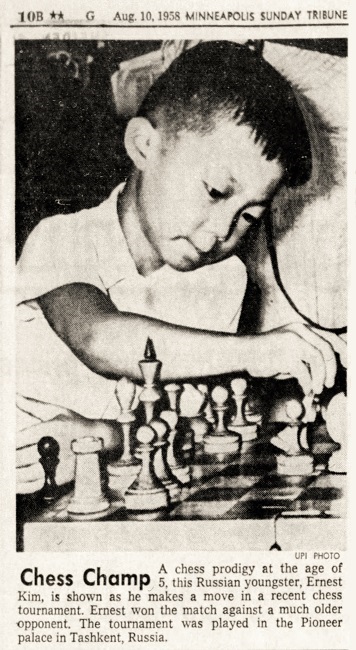
Minneapolis Star Tribune, 10 August 1958, page 10B
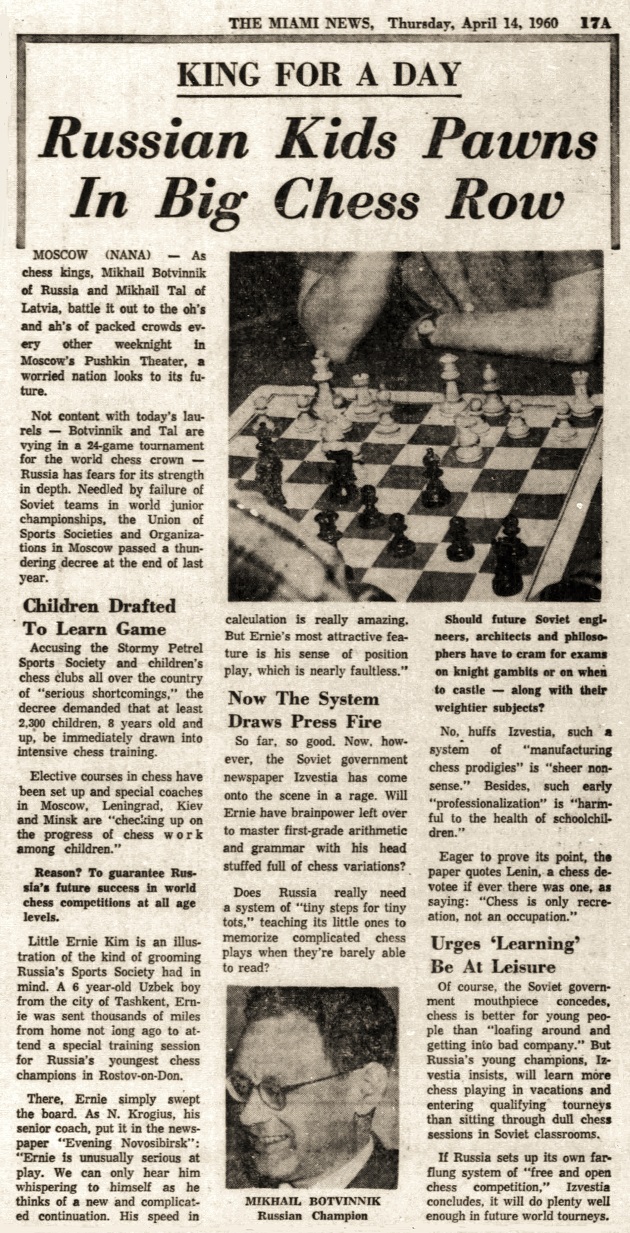
Miami News, 14 April 1960, page 17A
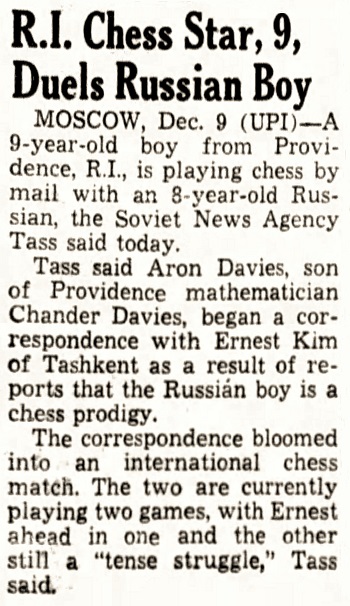
Boston Globe, 9 December 1961, page 7.
11069.
William H. Cubison (C.N.s 11060 & 11065)
William D. Rubinstein (Melbourne, Australia) and Gerard Killoran (Ilkley, England) note the information about William Henry Cubison at the London Street Views website.
Mr Killoran adds that he has found only one William Cubison alive in London in the nineteenth century: William Henry Cubison, who was born on 5 April 1814. See Ancestry.com: Church of England Births and Baptisms 1813-1912. He adds this notice from page 5 of the Dover Express and East Kent News, 23 March 1906:

If the above birth-date is correct, Cubison died at the age of 91.
11070. A new book on Emanuel Lasker
A book of truly exceptional quality has just arrived: Emanuel Lasker edited by Richard Forster, Michael Negele and Raj Tischbierek:

A beautiful 450-page hardback, entirely in English, it is the first volume in a trilogy adapted from, and expanding on, Emanuel Lasker Denker Weltenbürger Schachweltmeister edited by Richard Forster, Stefan Hansen and Michael Negele (Berlin, 2009). We have a feature article on that 1,079-page work.
The new book can be ordered direct from a webpage of Exzelsior Verlag, Berlin or by contacting the company by e-mail (info@exzelsior.de).
We are grateful to the Editors for permission to show here three photographs which they obtained from the collection of the late Lothar Schmid:

Page XIV: Emanuel Lasker, circa 1897
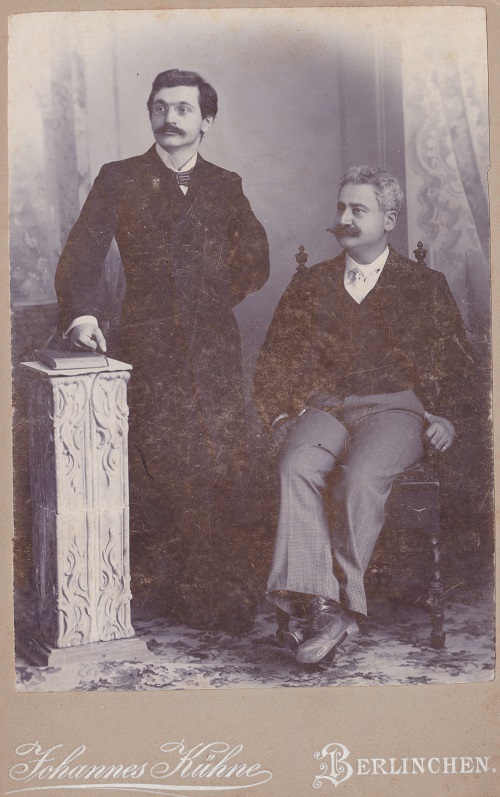
Page 186: Emanuel Lasker ‘probably with his father Michaelis Aron’, 1899
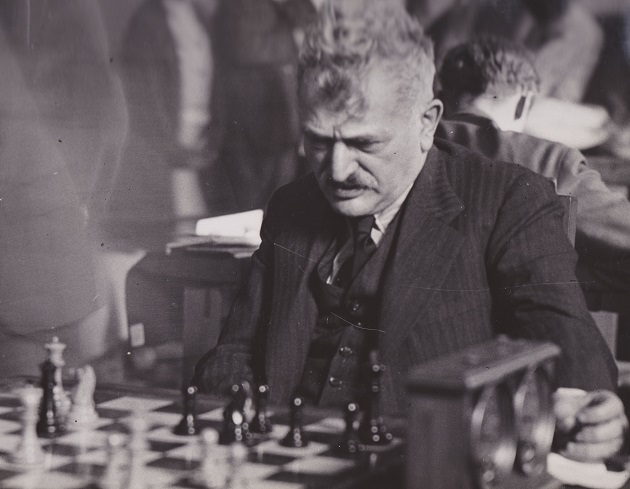
Page 140: Emanuel Lasker (first-round game against Reuben Fine, Nottingham, 1936).
11071. Sty-nits
The new Lasker book (C.N. 11070) has some further information about W.H. Cubison, who was discussed in C.N.s 11060, 11065 and 11069. For example, a footnote on page 33 states that he was ‘an accountant by training and for many years secretary of the London Association for the Protection of Trade’. C.N. 11060 referred to Steinitz’s suggestion, later withdrawn, that Cubison composed the ‘Sty-nits’ poem published by the Chess Monthly.
On the ‘Sty-nits’ topic, below is the sequence of items in the Chess Monthly, edited by Hoffer, and the International Chess Magazine, edited by Steinitz:
Chess Monthly, May 1889, pages 264-265:
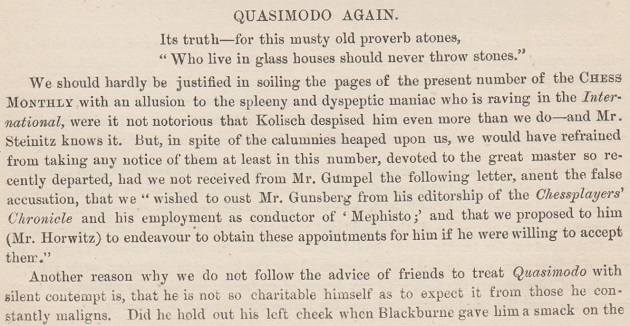
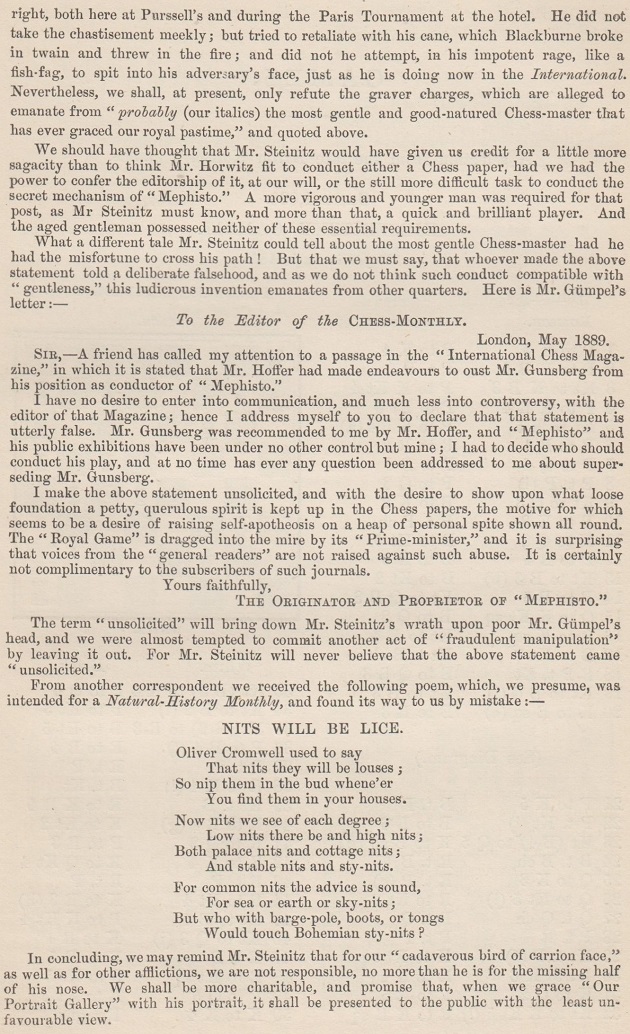
International Chess Magazine, June 1889, page 180:
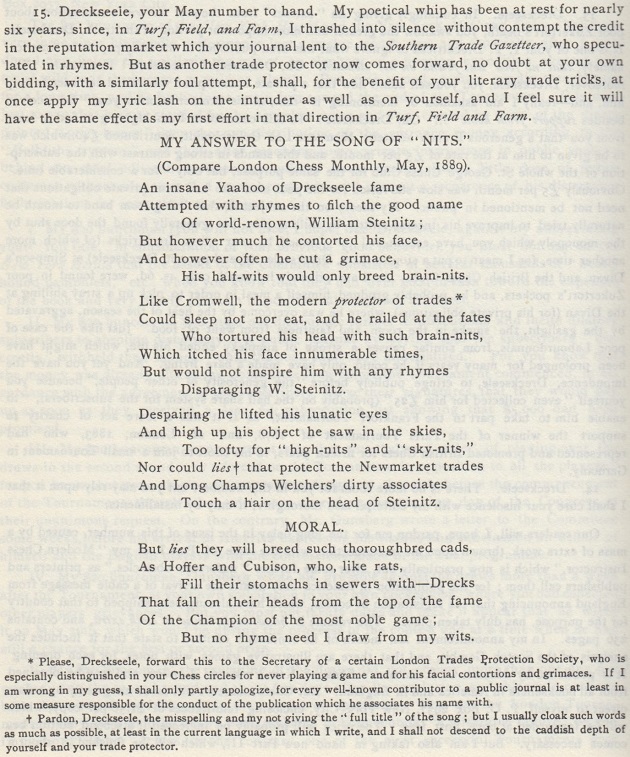
Chess Monthly, September 1889:
A further poem was published in this issue but subsequently withdrawn and replaced by other matter. The 30-verse poem, ‘Song of a Nit’, was reproduced on pages 223-225 of Kurt Landsberger’s first book on Steinitz, but our bound volume of the Chess Monthly has only the replacement material (tournament reports). The same applies to the copies of the Chess Monthly held by libraries and other colleagues whom we have consulted so far. Can any reader send the pages of the September 1889 Chess Monthly which had the poem?
International Chess Magazine, October 1889, page 298:
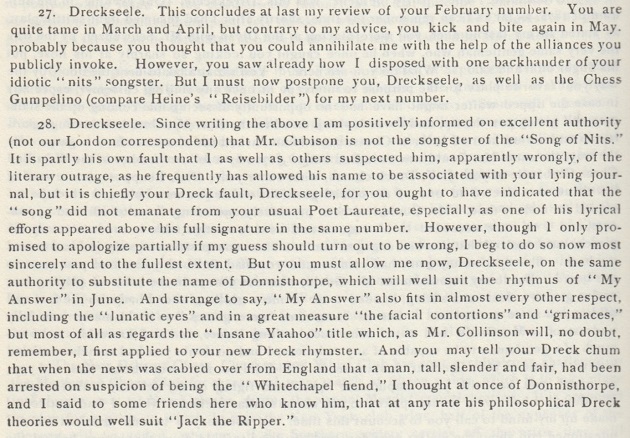
International Chess Magazine, November 1889, page 334:

International Chess Magazine, December 1889, pages 369-370:
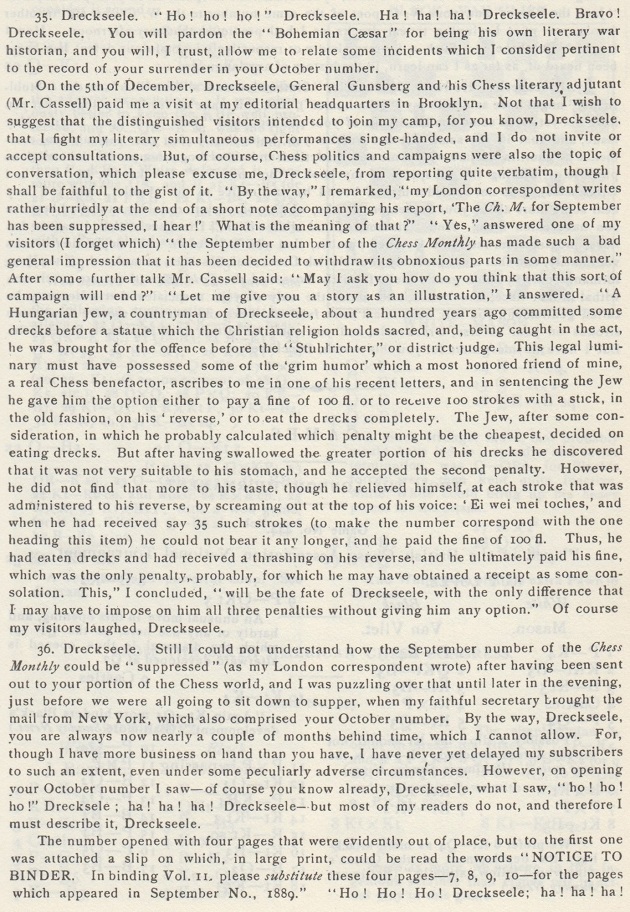
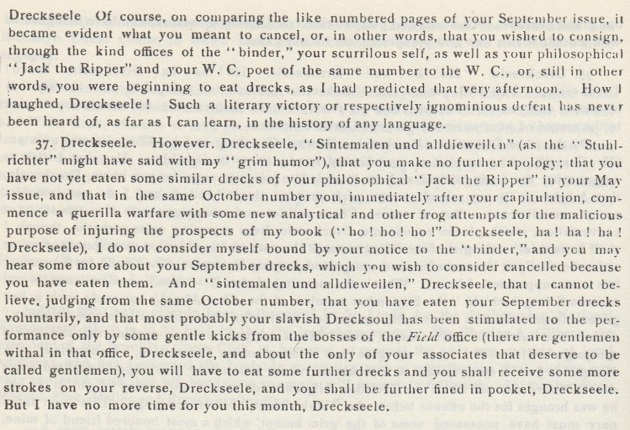
11072. Kurt Landsberger
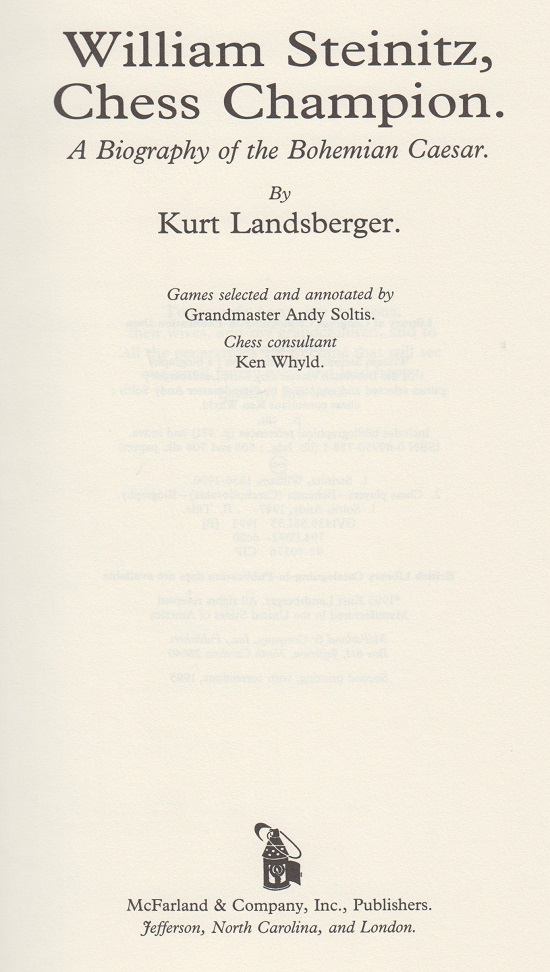
As regards the editorial and linguistic standards of William Steinitz, Chess Champion by Kurt Landsberger (Jefferson, 1993), on 14 September 1994 we wrote a letter to the publisher’s then President.
A ‘second printing, with corrections’ was produced in 1995, and a paperback edition in 2006.
11073. Ludwig Steinkohl (C.N. 11030)
Peter Anderberg (Harmstorf, Germany) notes that page 3 of Rochade Europa, May 1998 had an obituary of Ludwig Steinkohl which stated that he died in Bad Aibling on 8 April 1998:
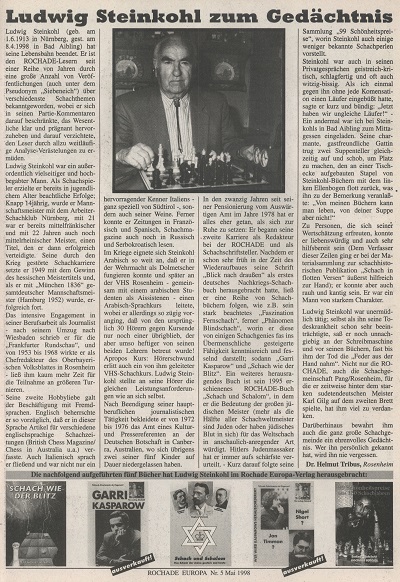
Our correspondent adds:
‘Although Steinkohl published a book about correspondence chess, the magazine Fernschach did not mention his death.’
11074. Jackson Whipps Showalter
In C.N. 5706 a correspondent reported that Showalter was born on 5 February 1859 and not, as commonly stated in reference books, on 5 February 1860. See too C.N. 6972.
Is further documentary evidence available?
11075. Bird and Buckle
Michael Clapham (Ipswich, England) refers to the mix-up over Bird and Buckle in a well-known picture (see Chess: Mistaken Identity) and adds that the same error is on page 178 of Pour Philidor edited by Jean François Dupont-Danican (Koblenz, 1994).
We note that the Bildnachweise on page 238 stated that the source for the picture was volume one of Verdens bedste skak by Jens Enevoldsen (Copenhagen, 1966). That book (page 89) was also wrong about Bird’s first forename:
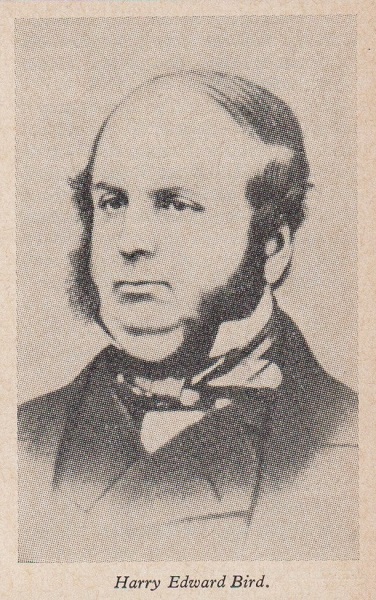
Henry Thomas Buckle
11076. Reading
From page 58 of the November 1918 Chess Amateur, under the heading ‘A Quaint Picture’:
‘In an old copy of the Illustrated London News, dated somewhere about 1857, we recently saw a wood engraving of a chess match at the Reading Town Hall – a quaint picture very well drawn, and interesting as showing the costumes of the period ...’
The picture was on page 195 of the Illustrated London News, 8 March 1851:
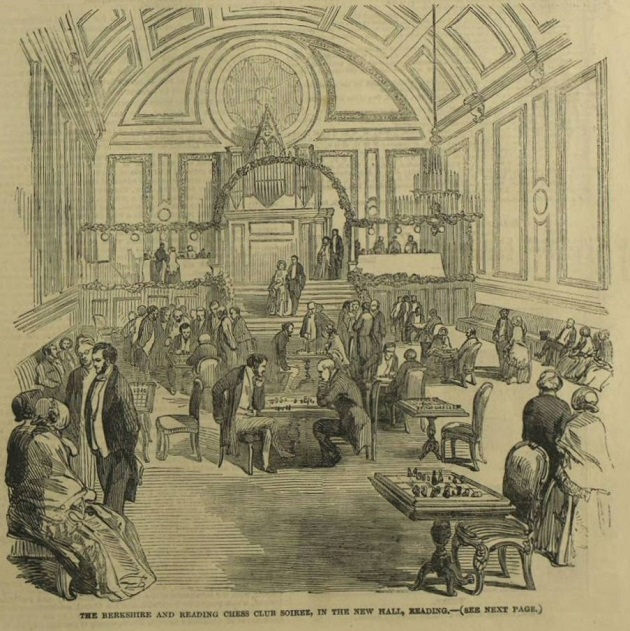
The following page included an account of Staunton’s presence:
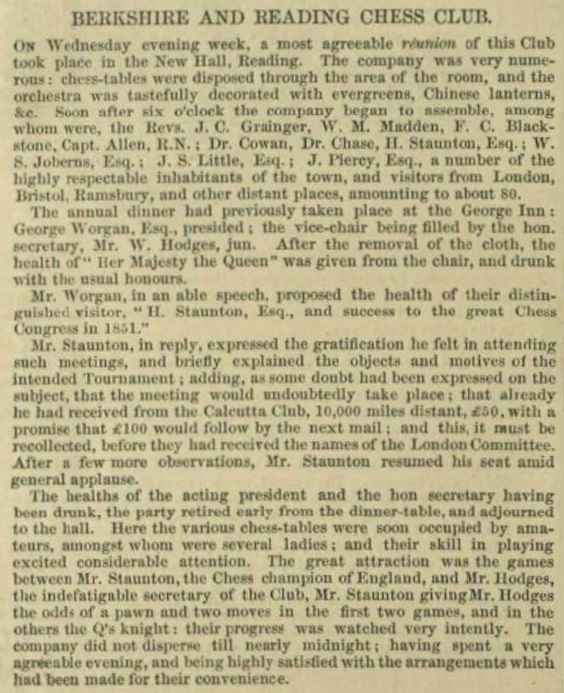
11077. Aaron Alexandre
Jean-Pierre Rhéaume (Montreal, Canada) comments on the relative scarcity of information about Aaron Alexandre in books and online.
As regards contemporary reports of his death, we note the following on page 407 of the Illustrated London News, 23 November 1850:

Almost the same text was on page 384 of the Chess Player’s Chronicle, 1850:
Page 8 of Bell's Life in London, 5 January 1851 stated that Alexandre had ‘died at his residence, Tavistock-row’.
Otto von Oppen wrote a lengthy obituary on pages 5-10 of the January 1851 Deutsche Schachzeitung:
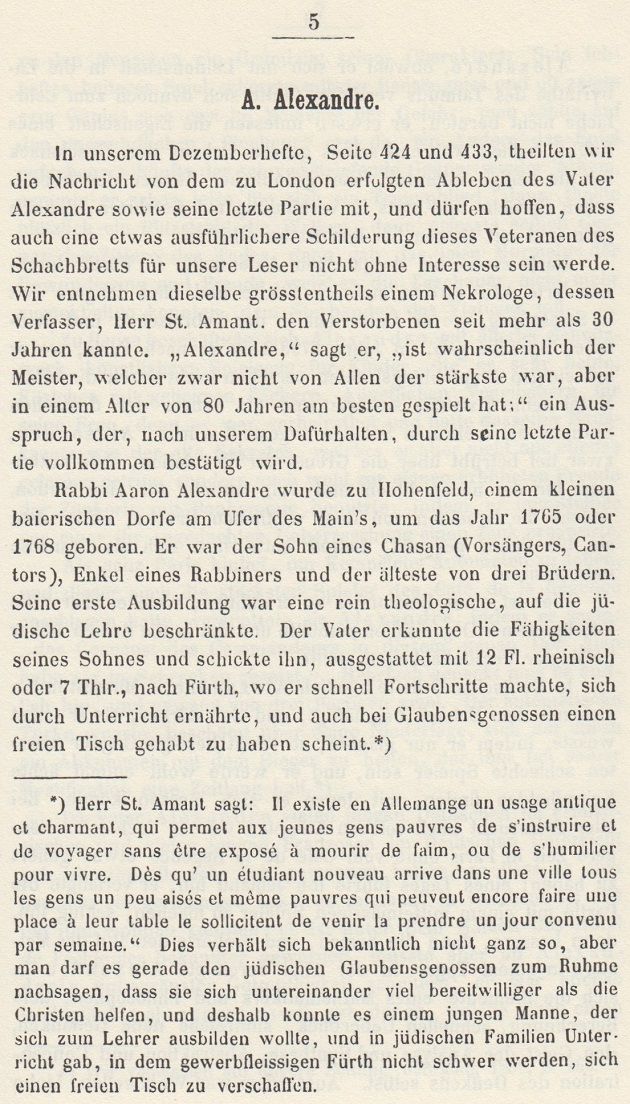
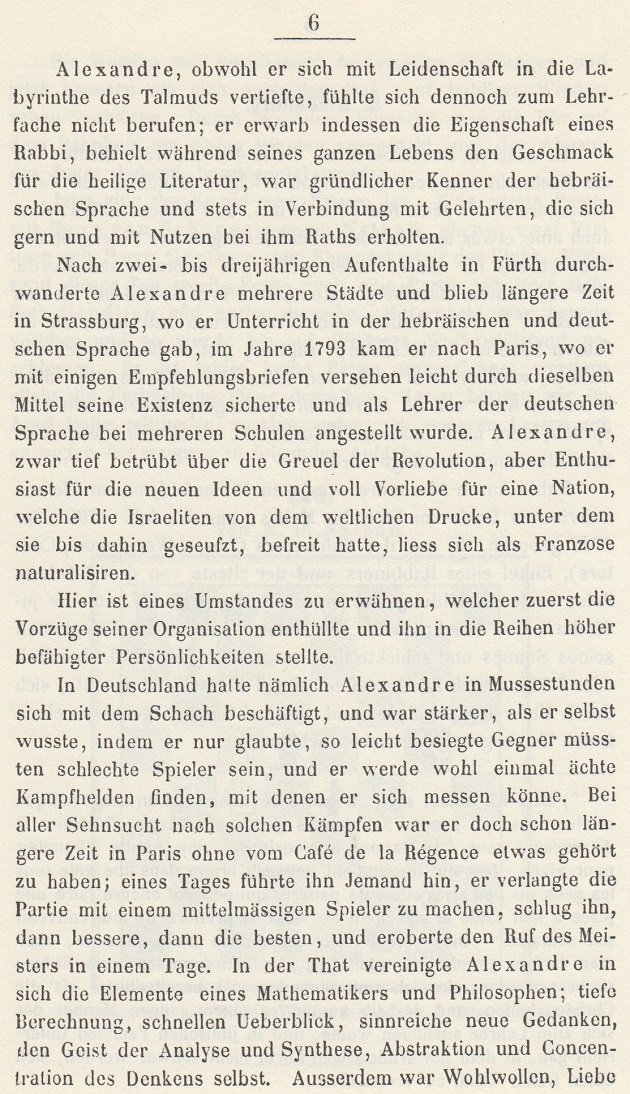
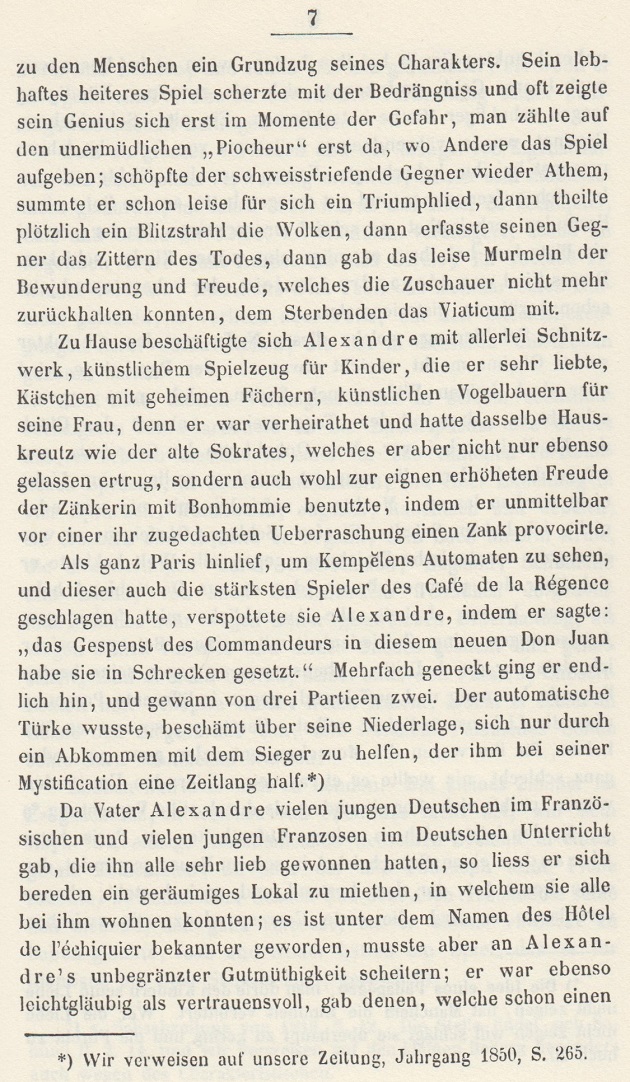
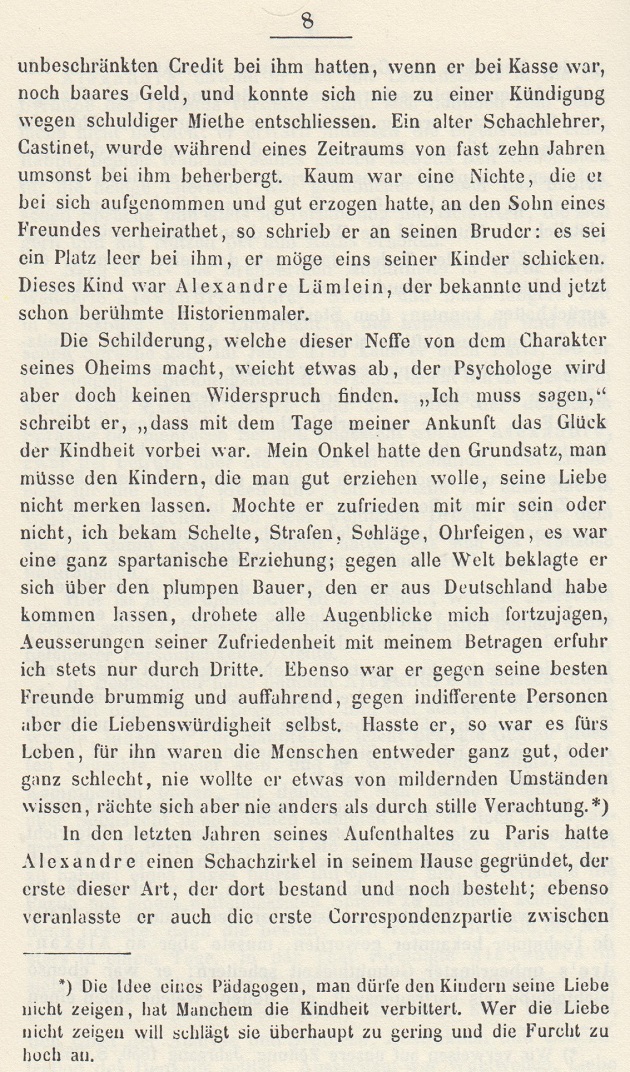
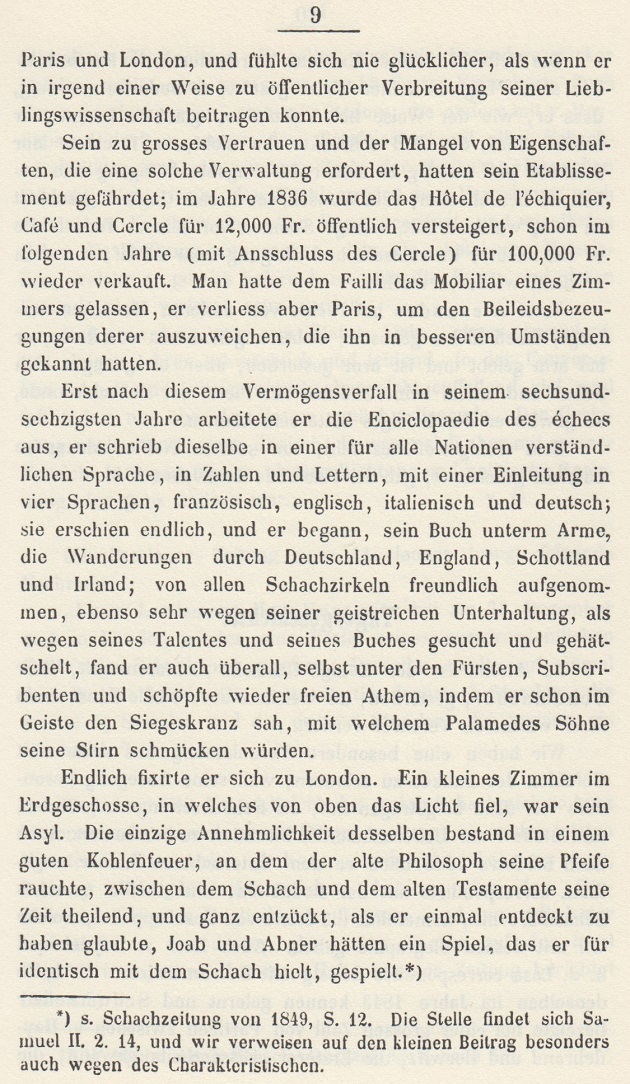
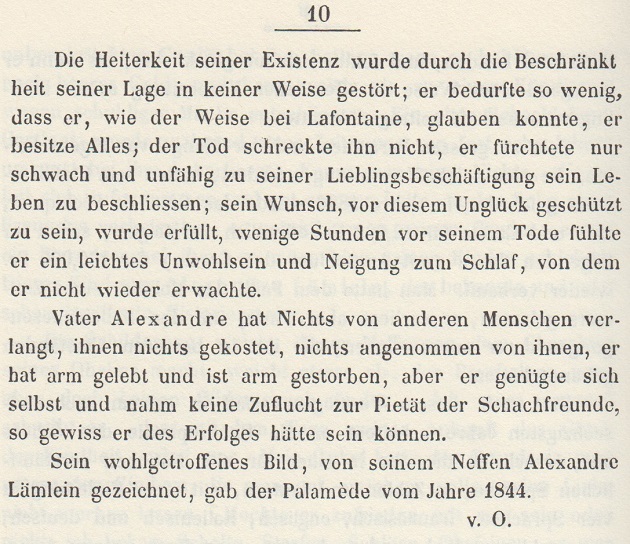
The portrait of Alexandre referred to in the final paragraph was the frontispiece to the 1844 volume of Le Palamède, and is widely available online. Identification of the artist as Alexandre’s nephew, Laemlein (i.e. Alexandre Laemlein), is on page 403 of the September 1845 issue of the French magazine.
11078. My 60 Memorable Games and Modern Chess Brilliancies (C.N. 11058)
Sean Robinson (Tacoma, WA, USA) notes that Larry Evans also mentioned Fischer’s verification of Modern Chess Brilliancies on page 1 of its 1994 algebraic edition (‘Fischer ... who reviewed this manuscript in 1969 before it went to press when he was a guest at my home in Reno’). There was no word about the review being performed blindfold. The 1970/71 book did not mention any involvement by Fischer.
The algebraic edition also reproduced, on pages 3-14, Evans’ Introduction to the original book. Although dated August 1969, it referred, on page 11, to ‘the stolid grinders like Smyslov, Petrosian, Karpov and Spassky’. Karpov’s name had naturally been absent from the 1970/71 book.
Comparing Modern Chess Brilliancies with Fischer’s My 60 Memorable Games (New York, 1969), our correspondent remarks that the books have 13 games in common, and he provides these extracts from the introductions:
- Fischer v Larsen, Portorož, 1958:
My 60 Memorable Games (page 18, under the heading ‘Slaying the dragon’): ‘In a laudable attempt to create complications, Larsen deviates from the book on move 15. ... an object lesson in how to mount an assault against the fianchettoed king.’
Modern Chess Brilliancies (page 198): ‘Fischer slays the Dragon Variation after an ill-advised attempt on the part of his opponent to complicate. The result is an object lesson in how to mount an assault against the fianchettoed king.’
- Letelier v Fischer, Leipzig, 1960:
My 60 Memorable Games (page 137): ‘ ... Fischer causes the overextended White center to crumble. Letelier, busily engaged on a material hunt, neglects to safeguard his rear ... Fischer rapidly encircles the hapless monarch and, with a startling queen sacrifice, induces abdication.’
Modern Chess Brilliancies (page 73): ‘White overextends his center in his hunt for material and neglects to safeguard his rear. His hapless monarch, unable to castle, is soon forced to abdicate.’
- Gligorić v Fischer, Bled, 1961:
My 60 Memorable Games (page 187): ‘This draw has the charm of perfection. ... The economy and ingenuity displayed by both players produces [sic] a harmonious flow of movement, remarkable in its esthetic appeal.’
Modern Chess Brilliancies (page 74): ‘This draw has the charm of perfection. The timing and ingenuity displayed by both players produce a harmonious flow of movement, remarkable in its aesthetic appeal.’
- Fischer v Bolbochán, Stockholm, 1962:
My 60 Memorable Games (page 212): ‘... Bolbochan, burdened with a bad bishop against a good knight, defends with extreme care but is gradually forced to retreat behind his lines. ... Fischer’s invasion on the weakened squares is a model of accuracy. It culminates in a keen combination which, appropiately [sic], earned a tie for the first brilliancy prize.’
Modern Chess Brilliancies (page 196): ‘Burdened with a bad bishop against a good knight, Black defends with extreme care but is gradually forced to retreat behind his lines. Fischer’s invasion on the weakened squares is a model of accuracy, culminating in a keen combination.’
For our part, we have compared these passages with My 61 Memorable Games, which often made irrational textual changes. One example:
- Letelier v Fischer, Leipzig, 1960:
My 60 Memorable Games (page 137): ‘Letelier, busily engaged on a material hunt, neglects to safeguard his rear.’
My 61 Memorable Games (page 252): ‘Letelier continues to hunt for material, but he neglects to secure his rearmost vulnerabilities.’
11079. Colle and Menchik
An addition to the contradictory claims about who launched the Vera Menchik Club comes from page 108 of Das Spiel der Könige by Alfred Diel (Bamberg, 1983):

At Carlsbad, 1929 Vera Menchik lost her game against Edgard (not Edgar) Colle, played on 15 August 1929 (see page 260 of the tournament book). In June she had defeated him at a tournament in Paris (L’Echiquier, July 1929, pages 290-292).
11080. The Slav Defence
Concerning the tenth match-game between Lasker and Schlechter in Berlin, 1910, on page 80 of Kings of Chess (London, 1954) William Winter wrote after 1 d4 d5 2 c4 c6:
‘It is curious that nearly all the contemporary annotators condemned this move. It is, of course, one of the best methods of declining the Queen’s Gambit.’
From the book’s Introduction (page 11):
‘... the solitary Slav Defence played by Schlechter against Lasker’s Queen’s Gambit caused a buzz of astonishment throughout the chess world. One English commentator went so far as to place a note against Black’s second move: “To this weak move may be attributed the loss of the game.” He quite ignored the fact that, at one period, Black held a winning position, but the remark is interesting as indicative of the narrow outlook on the openings during the first decade of the century.’
A spot-check of annotations written in 1910 suggests that the comments in Kings of Chess about the reaction to 2...c6 are an exaggeration. Two rare cases of outright condemnation of the move are on page 130 of La Stratégie, April 1910, attributed to, respectively, Tarrasch and the New Orleans Times-Democrat:
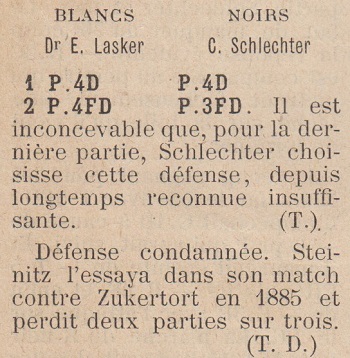
The New Orleans Times-Democrat (13 March 1910, page 9, part three) had not only the incorrect date 1885 but also a longer text whose second and third lines were inverted:

On this topic, see Old Opening Assessments.
11081. Capablanca in Paris (C.N. 6481)
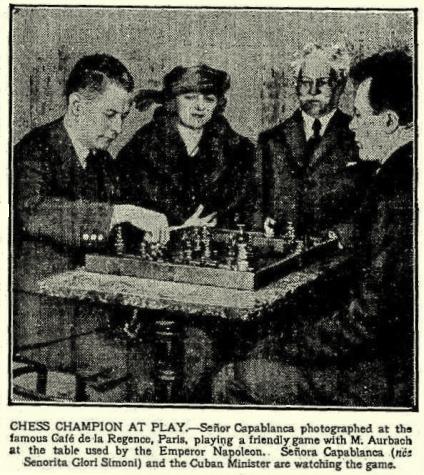
The Times, 30 March 1922, page 16
The request in C.N. 6481 for a better copy of this photograph has been answered by Eduardo Bauzá Mercére (New York, NY, USA). It comes from page 6 of the picture section of the New York Times, 30 April 1922:
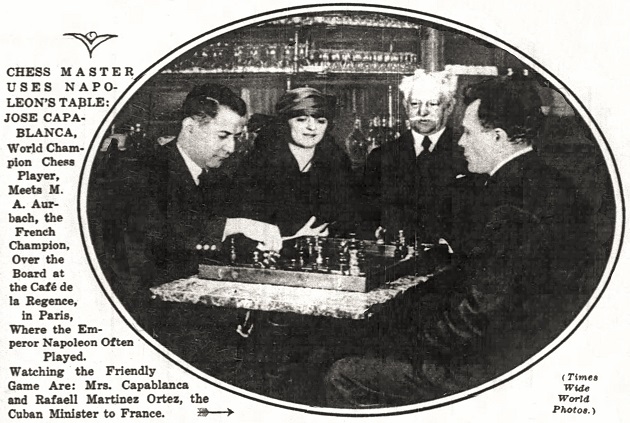
| First column | << previous | Archives [171] | next >> | Current column |
Copyright: Edward Winter. All rights reserved.
